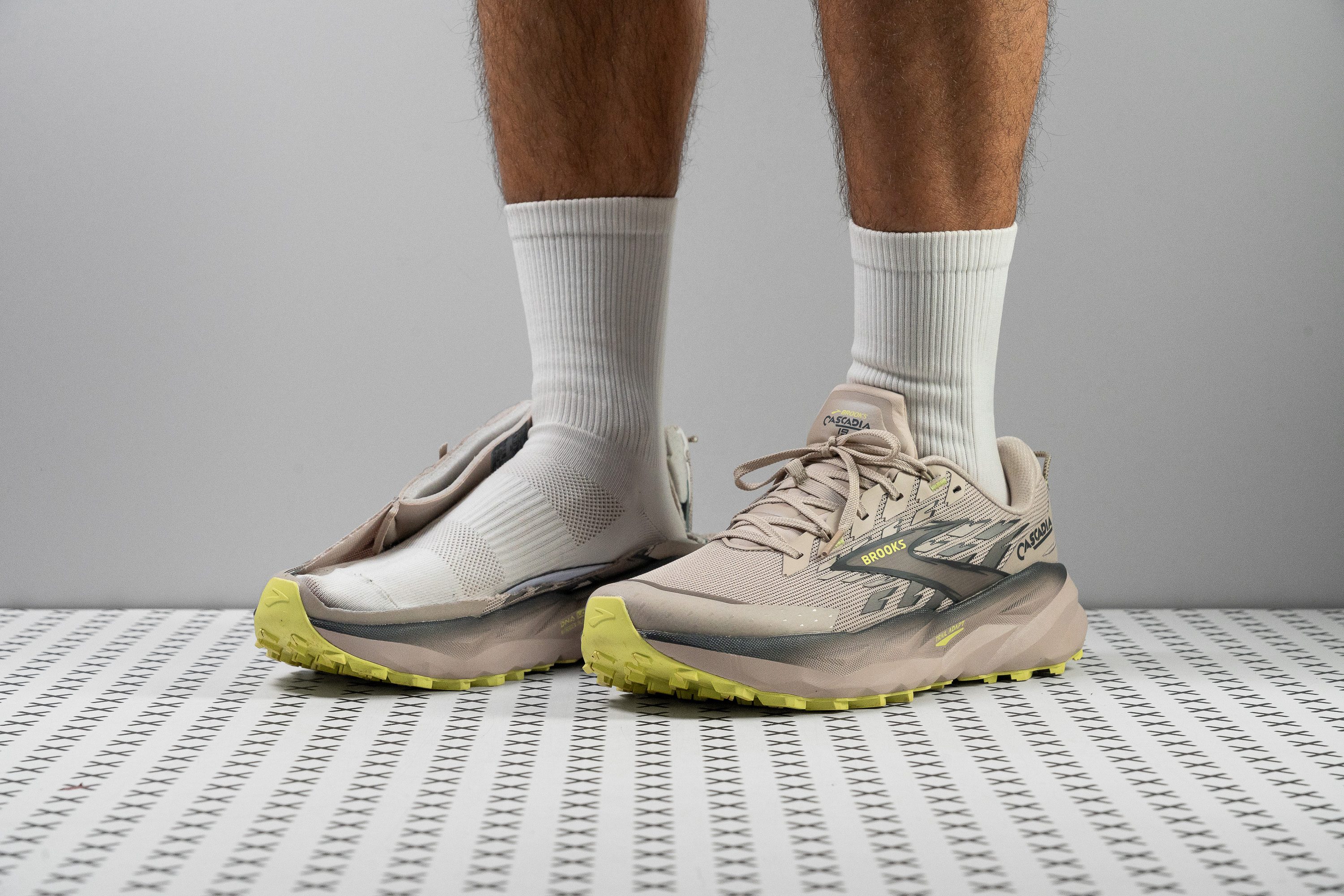Our verdict
- Top pick in best Brooks running shoes
- Top pick in best Brooks trail running shoes
Pros
- Softer, more responsive DNA Loft v3 foam
- Outstanding stability
- Enhanced flexibility
- Highly versatile for both running and hiking
- Reliable traction
- Well-crafted, plush tongue
- Excellent outsole durability
- Best Cascadia to date
- Good airflow
Cons
- Still on the heavier side
- Narrow toebox limits toe splay
- Slight price increase
Audience verdict
- Top 30% most popular running shoes
Comparison
The most similar running shoes compared
+ + Add a shoe | |||||
|---|---|---|---|---|---|
| Audience score | 85 Good! | 88 Great! | 83 Good! | 78 Decent! | |
| Price | $150 | $140 | $125 | $155 | |
| Trail terrain | LightModerate | Light | Light | Moderate | |
| Shock absorption | Moderate | Moderate | Moderate | Moderate | |
| Energy return | Moderate | Moderate | Low | Low | |
| Traction | High | - | - | - | |
| Arch support | Neutral | Neutral | Neutral | Neutral | |
| Weight lab Weight brand | 10.8 oz / 306g 10.7 oz / 303g | 10.2 oz / 288g 10 oz / 283g | 10.1 oz / 285g | 9.8 oz / 278g 9.8 oz / 277g | |
| Drop lab Drop brand | 7.8 mm 6.0 mm | 7.0 mm 8.0 mm | 9.1 mm | 4.9 mm 5.0 mm | |
| Strike pattern | Mid/forefoot | Mid/forefoot | HeelMid/forefoot | Mid/forefoot | |
| Size | True to size | True to size | True to size | Slightly small | |
| Midsole softness | Balanced | Balanced | Balanced | Balanced | |
| Difference in midsole softness in cold | Normal | Normal | Normal | Small | |
| Plate | Rock plate | Rock plate | Rock plate | ✗ | |
| Toebox durability | Good | Good | Decent | Good | |
| Heel padding durability | Decent | Good | Bad | Good | |
| Outsole durability | Good | Good | Good | Decent | |
| Breathability | Moderate | Moderate | Breathable | Warm | |
| Width / fit | Medium | Medium | Narrow | Medium | |
| Toebox width | Medium | Medium | Medium | Medium | |
| Stiffness | Moderate | Stiff | Moderate | Stiff | |
| Torsional rigidity | Stiff | Stiff | Stiff | Stiff | |
| Heel counter stiffness | Stiff | Stiff | Moderate | Moderate | |
| Lug depth | 3.8 mm | 3.3 mm | 3.4 mm | 4.0 mm | |
| Heel stack lab Heel stack brand | 34.8 mm 35.0 mm | 33.8 mm 34.0 mm | 33.5 mm | 32.1 mm 40.0 mm | |
| Forefoot lab Forefoot brand | 27.0 mm 29.0 mm | 26.8 mm 26.0 mm | 24.4 mm | 27.2 mm 35.0 mm | |
| Widths available | NormalWide | Normal | Normal | NormalWide | |
| For heavy runners | ✓ | ✗ | ✗ | ✓ | |
| Season | All seasons | All seasons | SummerAll seasons | All seasons | |
| Removable insole | ✓ | ✓ | ✓ | ✓ | |
| Orthotic friendly | ✓ | ✓ | ✓ | ✓ | |
| Ranking | #206 Bottom 44% | #138 Top 38% | #270 Bottom 27% | #326 Bottom 12% | |
| Popularity | #112 Top 31% | #116 Top 32% | #215 Bottom 42% | #53 Top 15% |
Who should buy
After testing the Cascadia 19, we believe it’s a solid choice for:
- Long-time Cascadia fans who upgrade every one or two years. This is easily the best version so far.
- Runners seeking a versatile, stable, and highly durable trail shoe.
- Hikers or summer trail runners who value plush comfort paired with great ventilation.
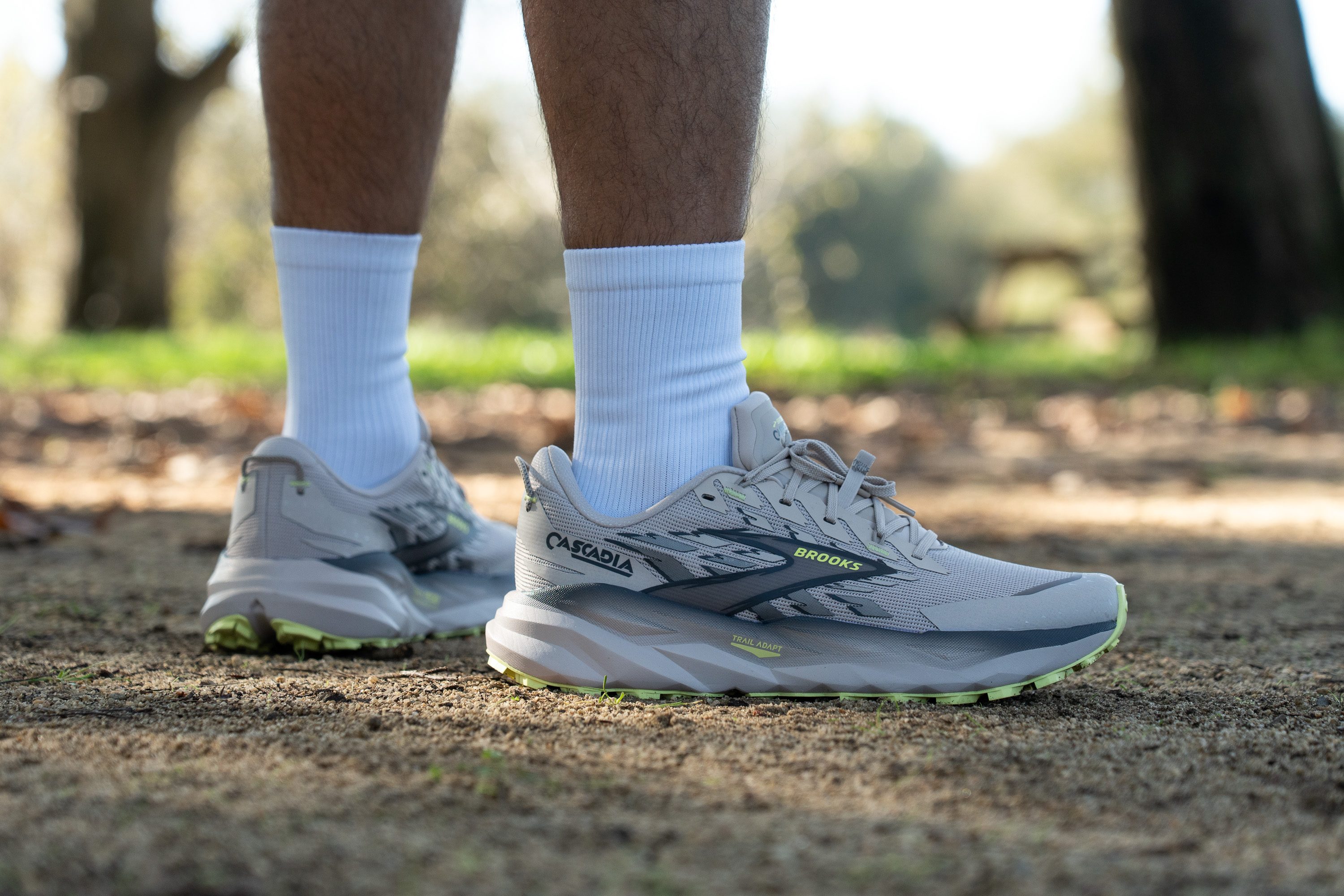
Who should NOT buy
We believe that the Brooks Cascadia 19 isn’t the best pick for runners who prefer an agile, compact-feeling trail shoe. Its new ultra-wide midsole makes it feel more bulky than before. Based on our testing, we think shoes like the Nike Zegama 2 or the ASICS Gel Trabuco 13 deliver a smoother, more quick-moving ride for those who value agility.
Additionally, we think the Cascadia 19 may disappoint runners seeking deep, max-cushioned comfort for long ultras or recovery efforts. In our lab, the midsole’s protection level was moderate, not high. For that extra cushioning and and top-tier shock absorption, we’d suggest the ASICS Trabuco Max 4 or the HOKA Mafate 5 instead.

Cushioning
Shock absorption
Shock absorption is fairly average at 128 SA in the forefoot and 107 SA in the heel, which doesn’t surprise us. The Cascadia has never aimed to be a max-stack shoe, and it maintains a moderate height that perfectly matches its versatile personality.

| Cascadia 19 | 128 SA |
| Average | 122 SA |
Energy return
We heavily criticized the DNA Loft v2 foam of the Cascadia 18 for its lack of energy return and dull, uninspiring ride. We even said, word for word: “Maybe, after 18 versions, it’s finally time to make the leap.”
Well, Brooks delivered. The Cascadia 19 now features DNA Loft v3, a supercritical EVA foam that feels lighter, springier, and smoother underfoot. Although this improvement comes with a slight increase in price, which we’ll discuss later.
But how much of an upgrade is it really? Version 18 reached 54.1% energy return in the heel and 57.1% in the forefoot, while this one hits 59.4% and 60.4% respectively. It’s not a revolutionary leap as we can't expect miracles from an EVA-based compound, yet the foam feels far more pleasant and soft underfoot.
| Cascadia 19 | 59.4% |
| Average | 55.6% |
Heel stack
Running shoes keep getting taller each year, and Brooks responded by adding a few extra millimeters of foam to the Cascadia 19. The heel now measures 34.8 mm, up from 32.6 mm in the previous version.
However, since nearly every other shoe in the market has grown as well, the Cascadia 19 ends up feeling almost identical to its predecessor.
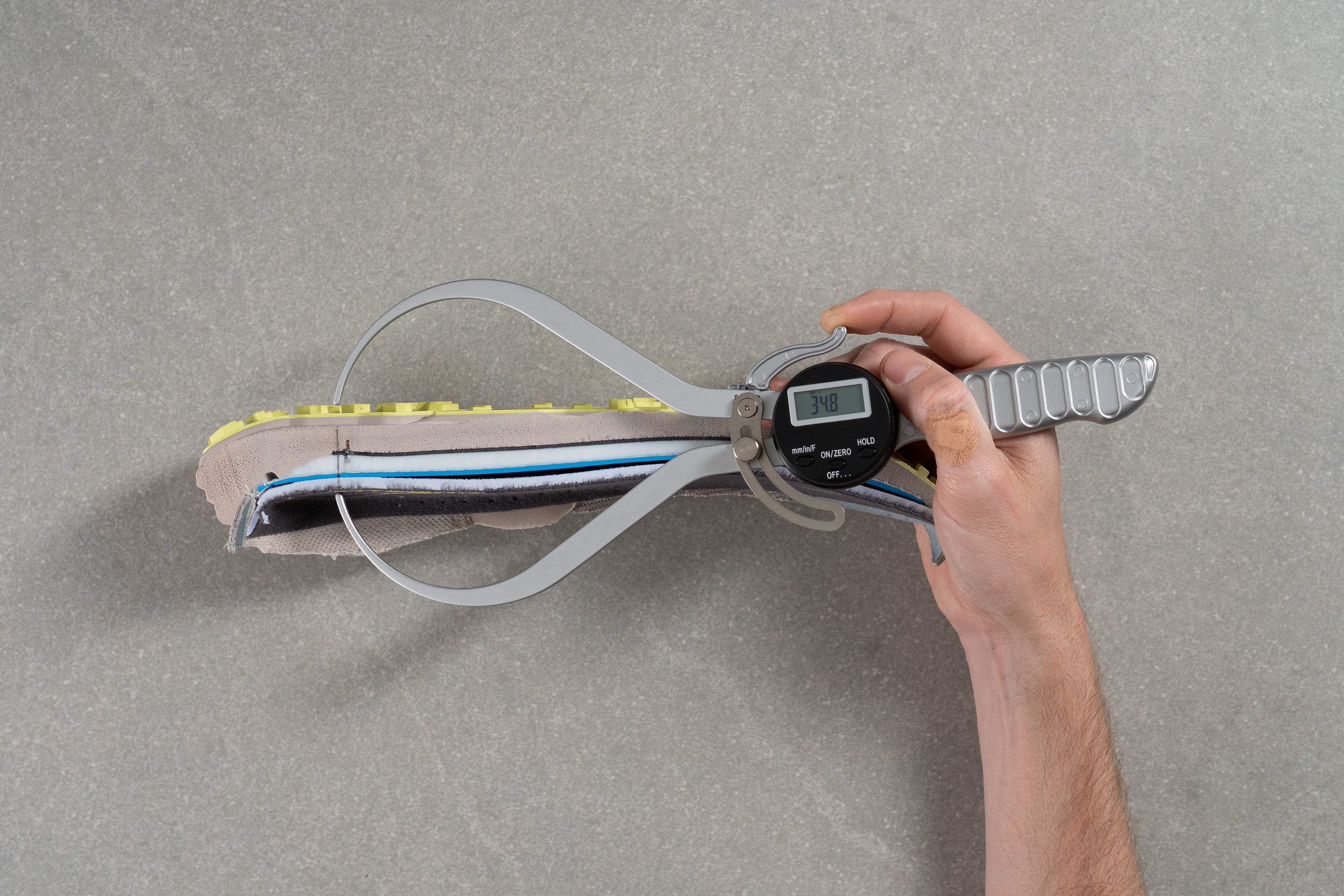
| Cascadia 19 | 34.8 mm |
| Average | 32.6 mm |
Forefoot stack
The forefoot now rises to 27.0 mm, marking a noticeable improvement over the previous 23.8 mm. Runners who felt the front of version 18 lacked cushioning will surely appreciate this update, as it brings significantly more foam and comfort.
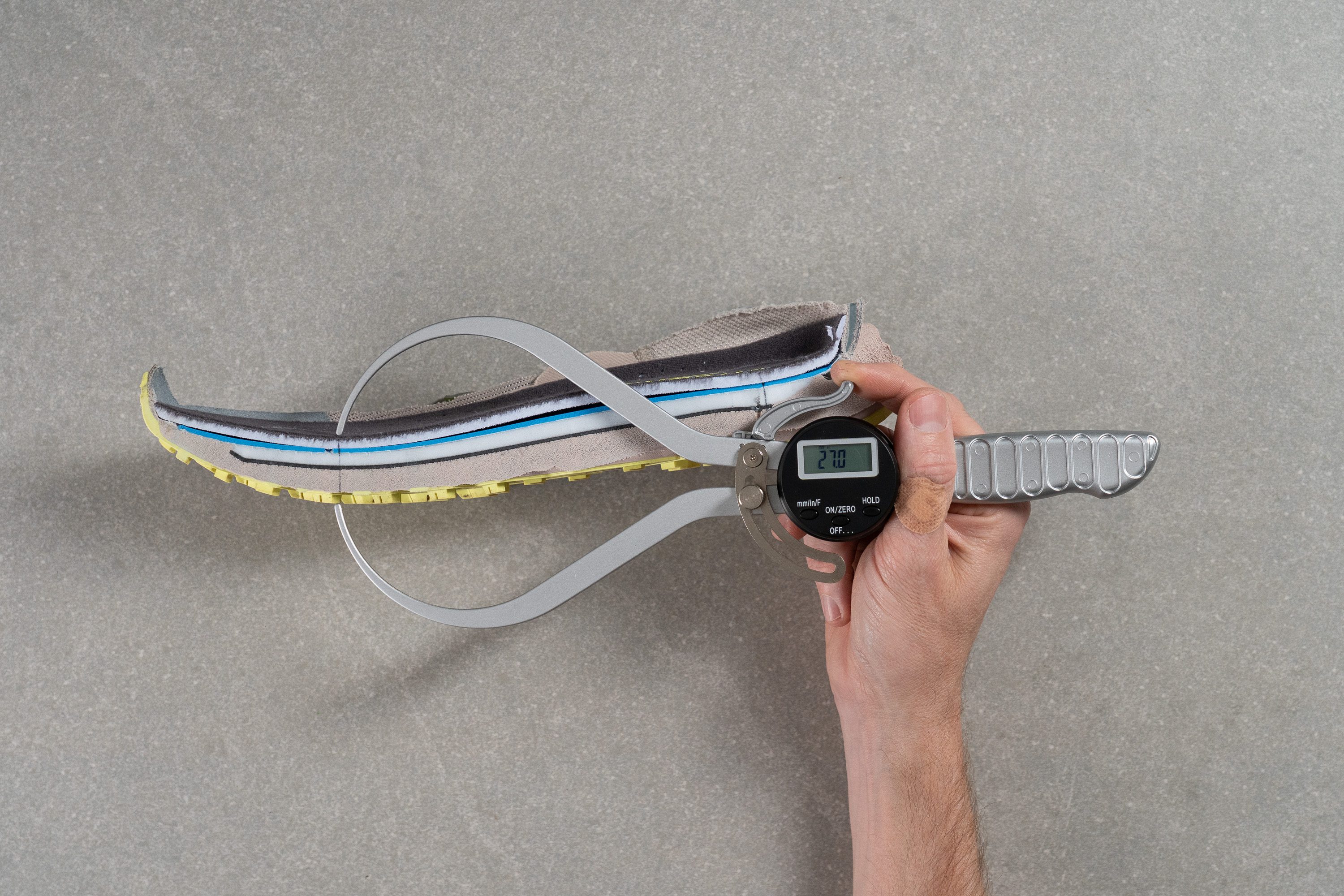
| Cascadia 19 | 27.0 mm |
| Average | 25.1 mm |
Drop
We measured a 7.8 mm heel-to-toe drop that feels natural and adaptable to any footstrike. It’s slightly higher than the 6 mm claimed by Brooks, but we doubt this small difference will bother most runners.
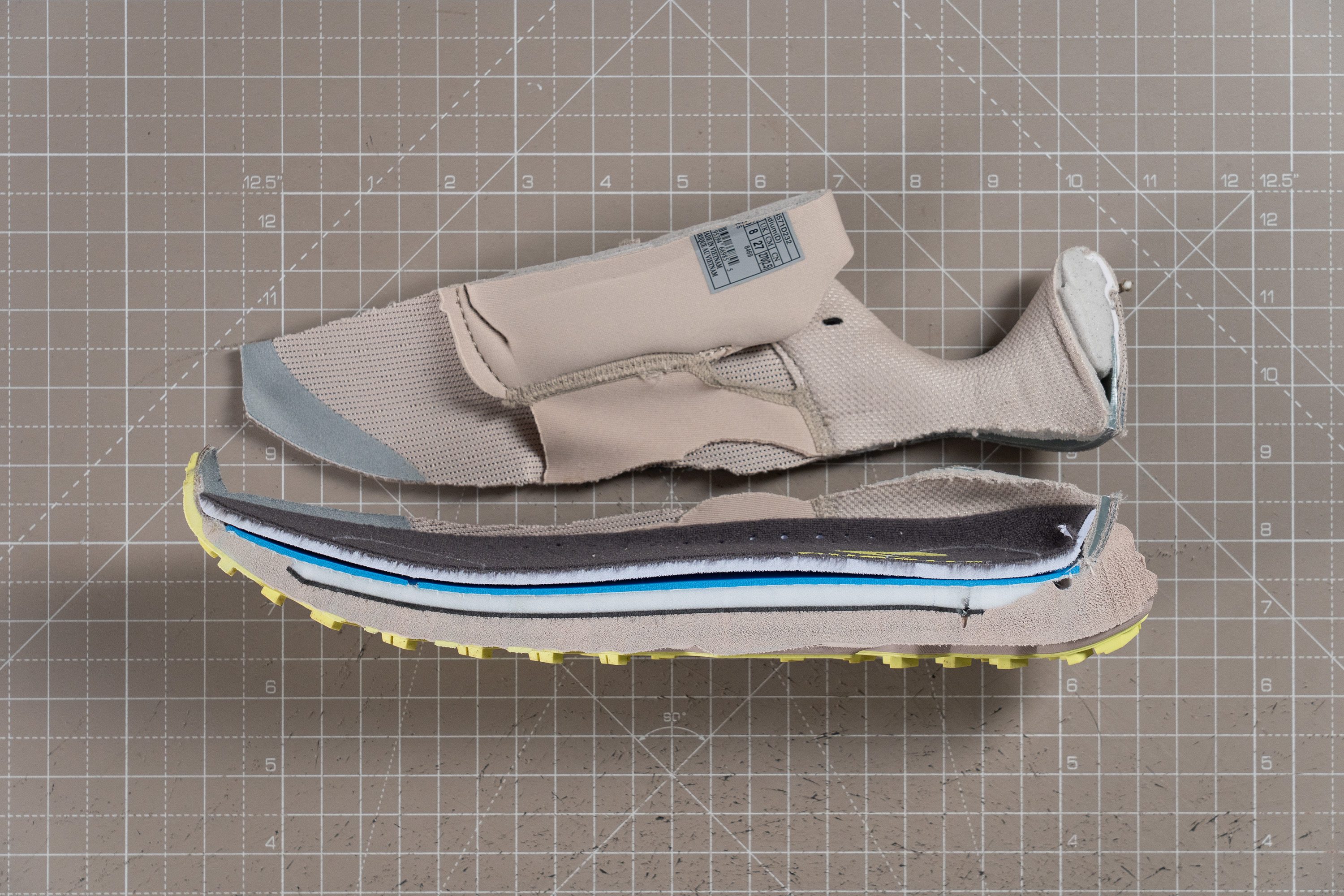
| Cascadia 19 | 7.8 mm |
| Average | 7.6 mm |
Midsole softness
The new DNA Loft v3 foam features two distinct layers: a thinner one sitting above the plate and a larger one positioned underneath.
We measured this main slab at 20.0 HA of softness, 27% lower than version 18. This change fully explains why, beyond its slightly livelier bounce, we found the Cascadia 19 noticeably softer and far more enjoyable to run in.
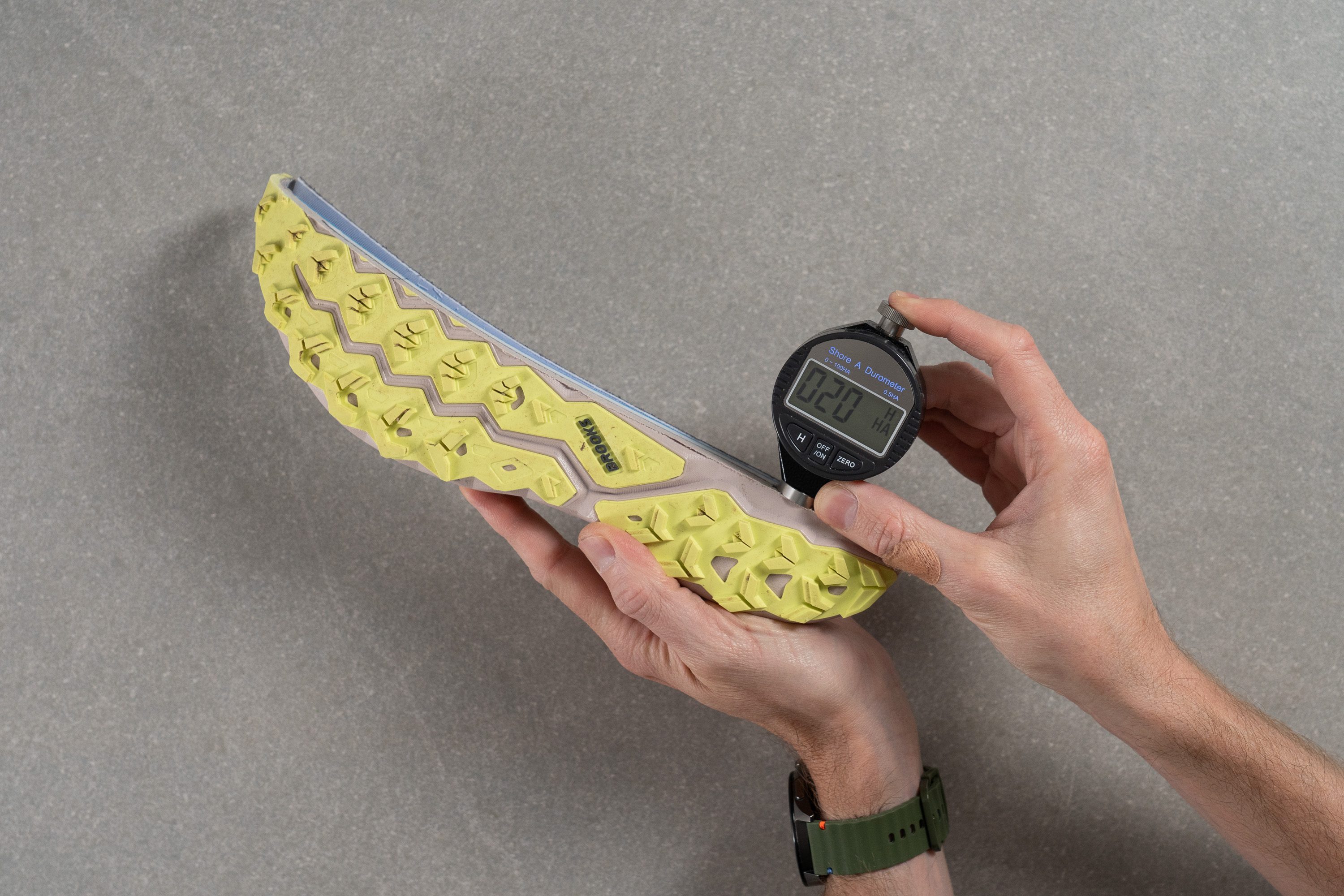
| Cascadia 19 | 20.0 HA |
| Average | 21.9 HA |
Secondary foam softness
The secondary layer sits above the plate and feels even softer at 18.0 HA.
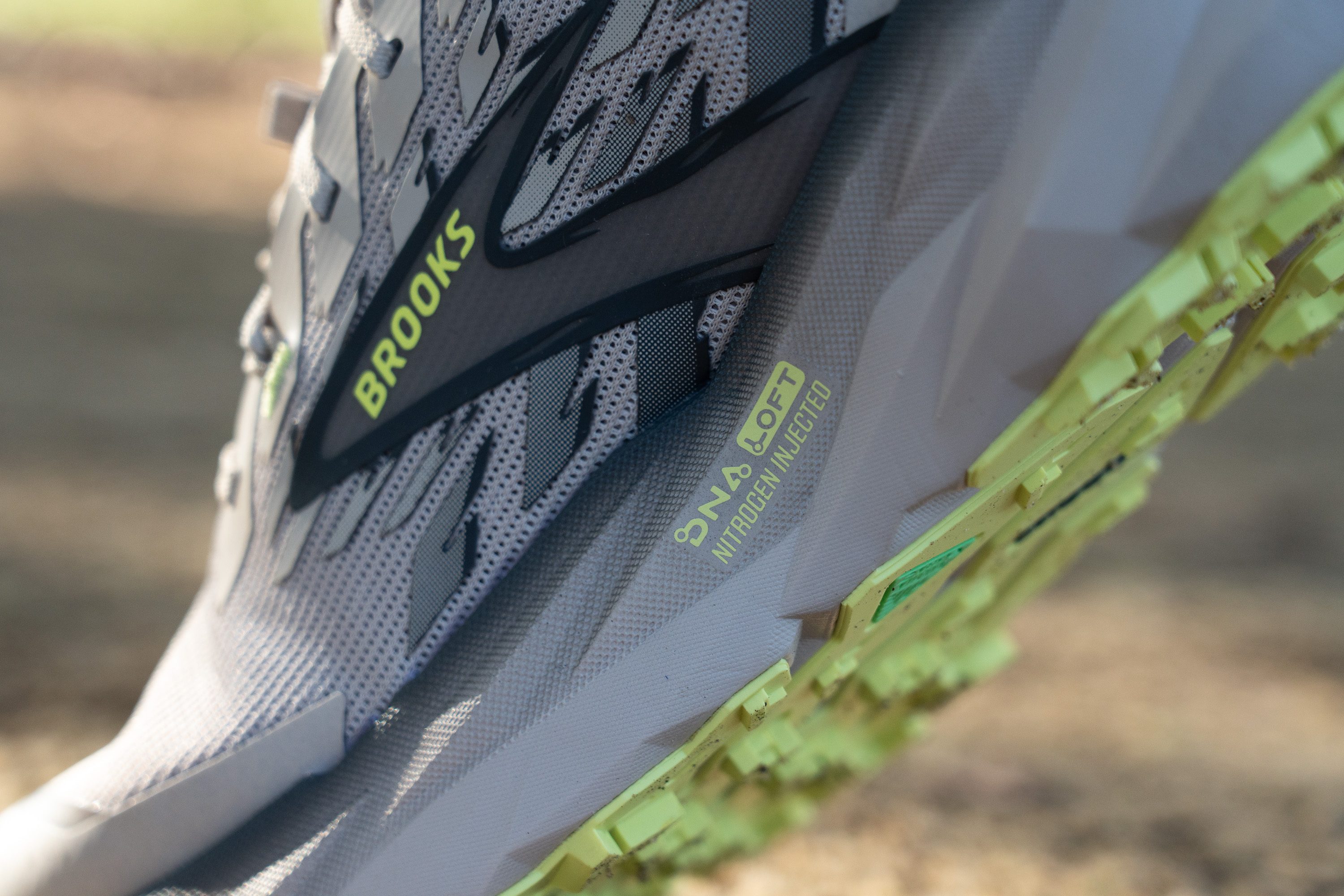
It’s a clever design choice by Brooks, offering a well-balanced mix of stability under the plate and a comfort-focused touch closer to the foot.

| Cascadia 19 | 18.0 HA |
| Average | 25.5 HA |
Rocker
With each rise in stack height, the Cascadia gains a slightly more curved midsole profile to balance the added foam. Still, it maintains a fairly traditional underfoot feel with a mild rocker, and it keeps the shoe versatile enough for hiking, just like always.
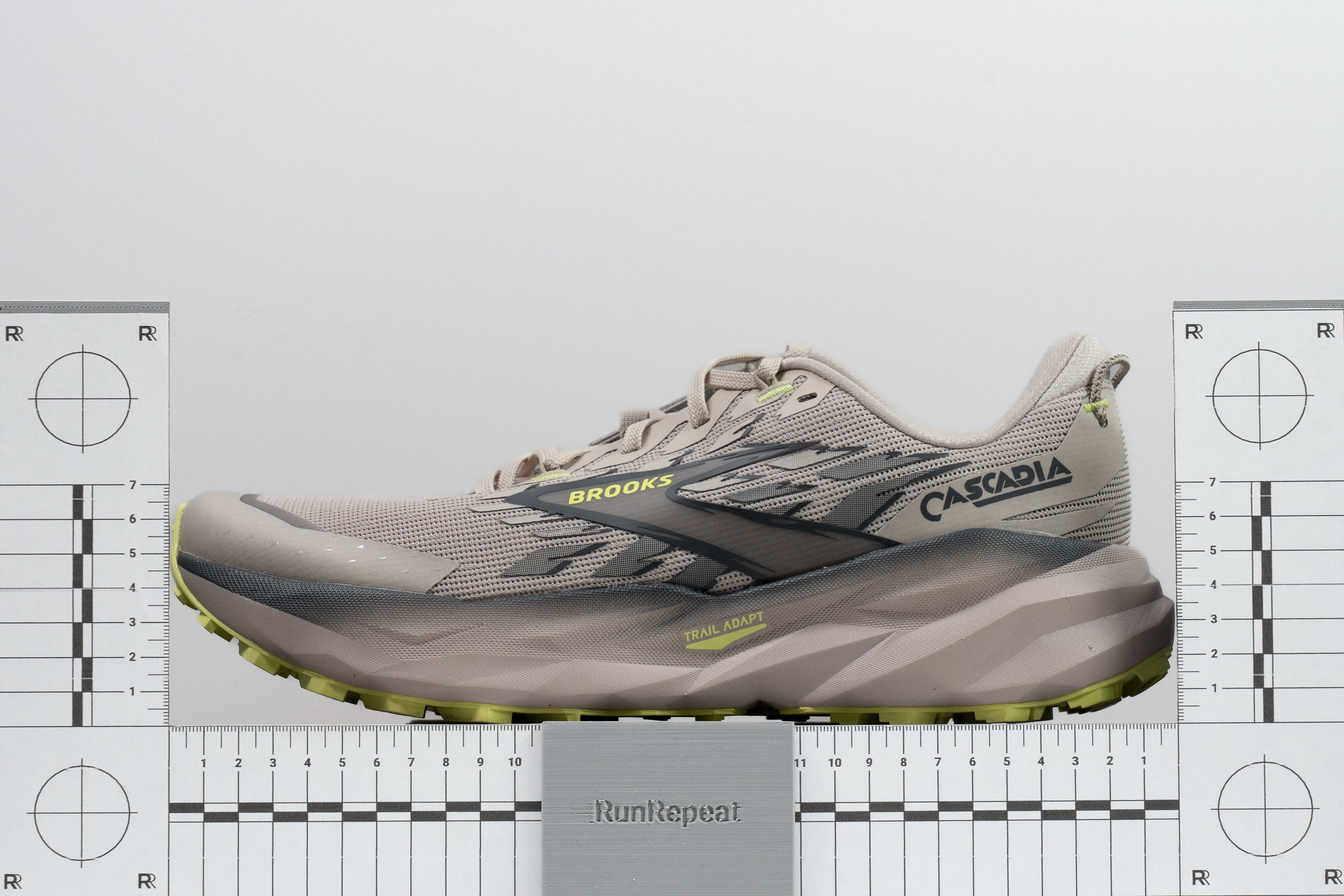
Plate
The Trail Adapt plate, a longtime staple of the Cascadia line, remains in place to improve stability while also adding some protection against potential hazards.
Also, our video clearly shows the midsole setup: the lower foam layer, the Trail Adapt plate, and the softer upper layer.
Size and fit
Size
Brooks Cascadia 19 fits true to size (21 votes).
Width / Fit
Brooks offers the Cascadia in both standard and wide sizes, though the wide version is only sold in select regions. We purchased a standard US 9 for our tests (as always) and created our gel mold of the interior.
Once solidified, we measured 95.7 mm in width, confirming a versatile design meant to accommodate a wide range of trail runners.
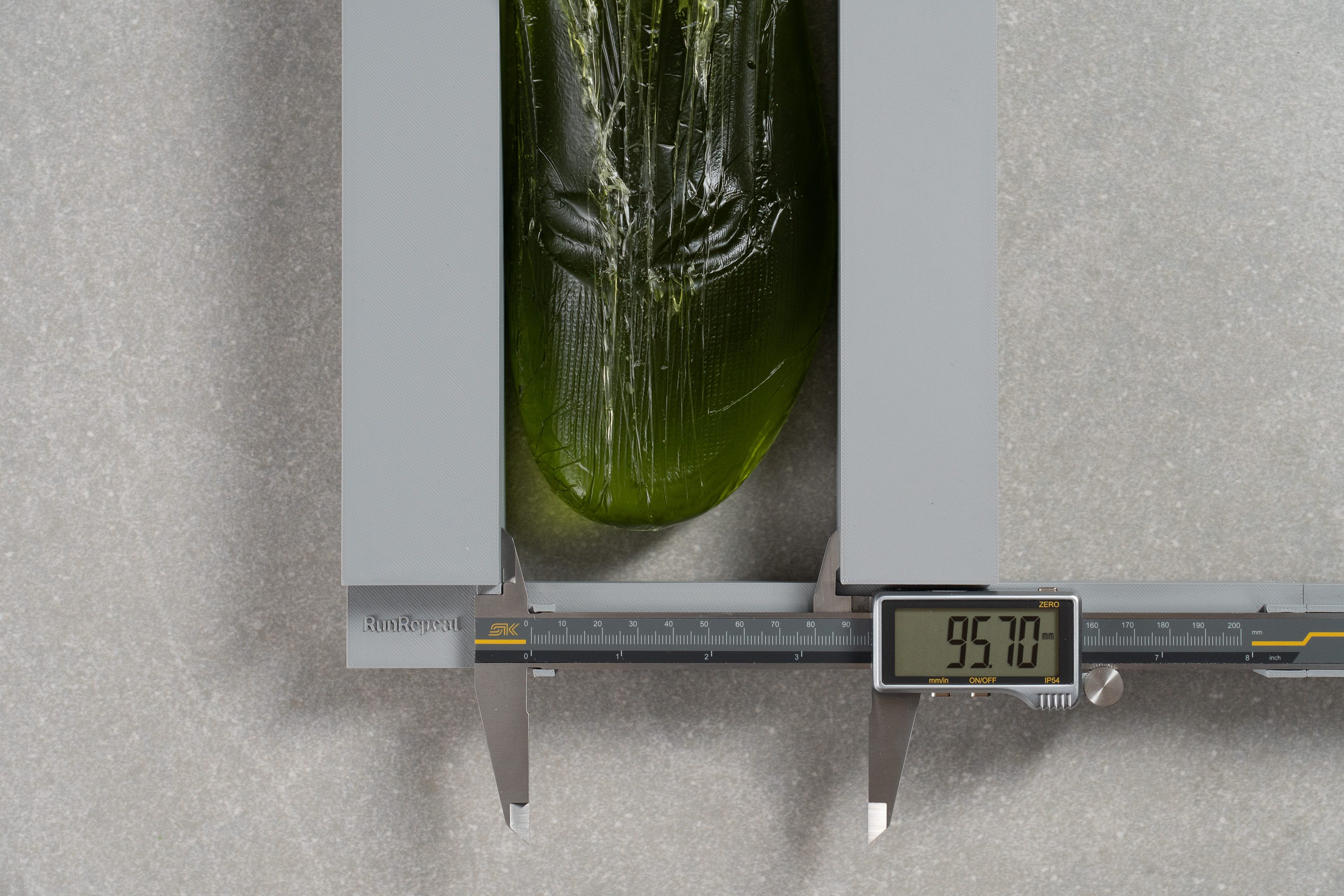
| Cascadia 19 | 95.7 mm |
| Average | 95.6 mm |
Toebox width
The toebox is slightly narrower than we expected at 72.5 mm, offering 2.7 mm less space than the previous Cascadia. That's a noticeable reduction in room for toe splay.
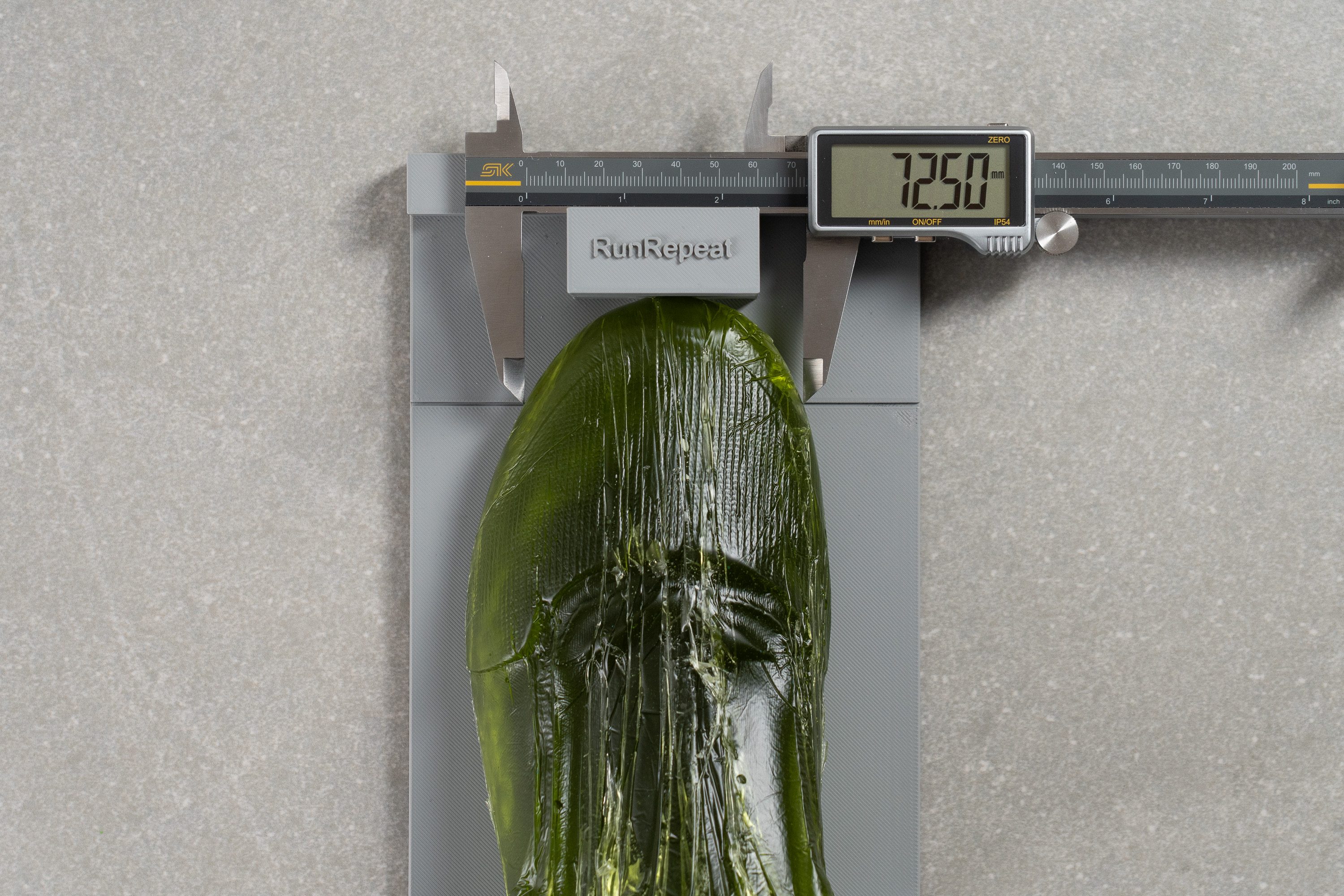
| Cascadia 19 | 72.5 mm |
| Average | 74.6 mm |
Toebox height
Toebox height is slightly lower than before, measuring 24.4 mm.
The difference isn’t huge and shouldn’t be a concern, as the upper material doesn’t create unwanted pressure. On the bright side, it enhances security on uneven terrain, keeping the foot securely in place.
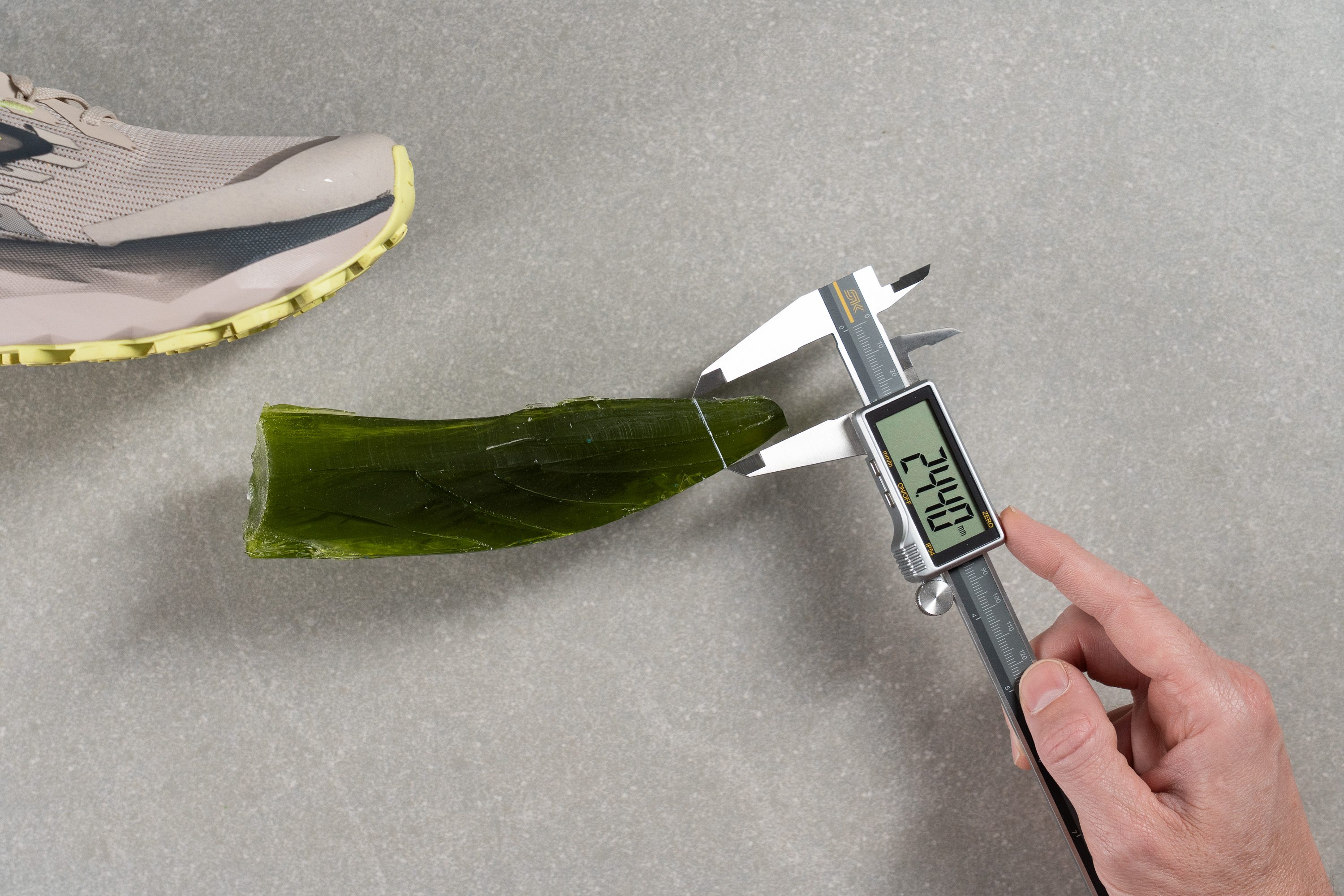
| Cascadia 19 | 24.4 mm |
| Average | 27.0 mm |
Traction / Grip
Forefoot traction
Brooks relies on its in-house TrailTack Green compound rather than teaming up with rubber specialists like Vibram. We’re fine with that decision, as our tests showed a 0.51 score that ensures dependable grip across diverse surfaces and weather conditions.
| Cascadia 19 | 0.51 |
| Average | 0.60 |
Lug depth
The Cascadia has always been promoted as a versatile all-terrain shoe built for both varied trails and long hikes, which naturally rules out ultra-deep lugs. That’s why the 3.8 mm lugs make perfect sense to us.
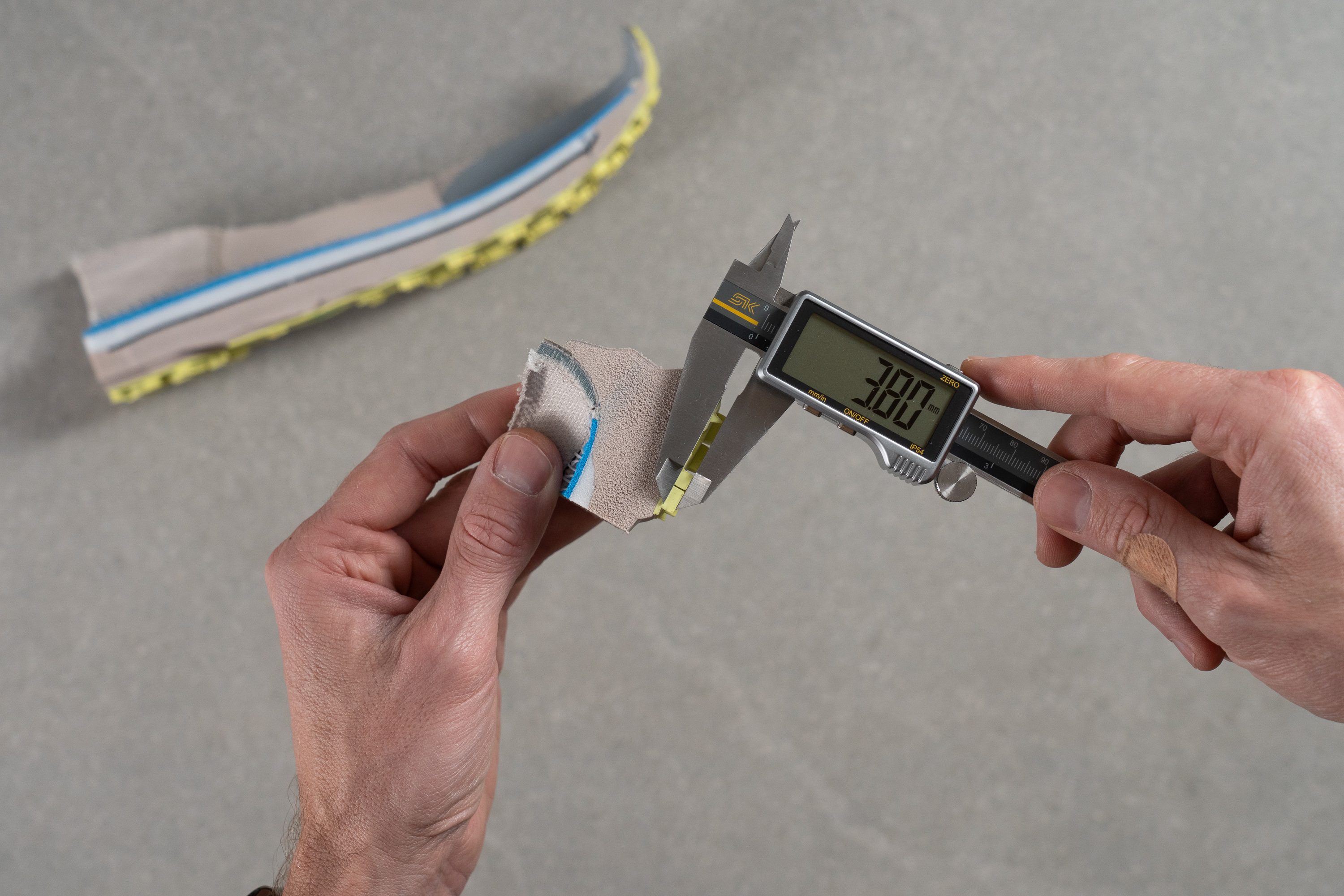
| Cascadia 19 | 3.8 mm |
| Average | 3.5 mm |
Outsole design
The Cascadia 19’s TrailTack Green outsole features a multi-angled lug layout designed for all-terrain grip. The forefoot lugs point forward to maximize uphill traction, while the rear ones face backward for confident downhill braking. We also found central zigzag grooves to boost torsional flexibility and debris or water release.
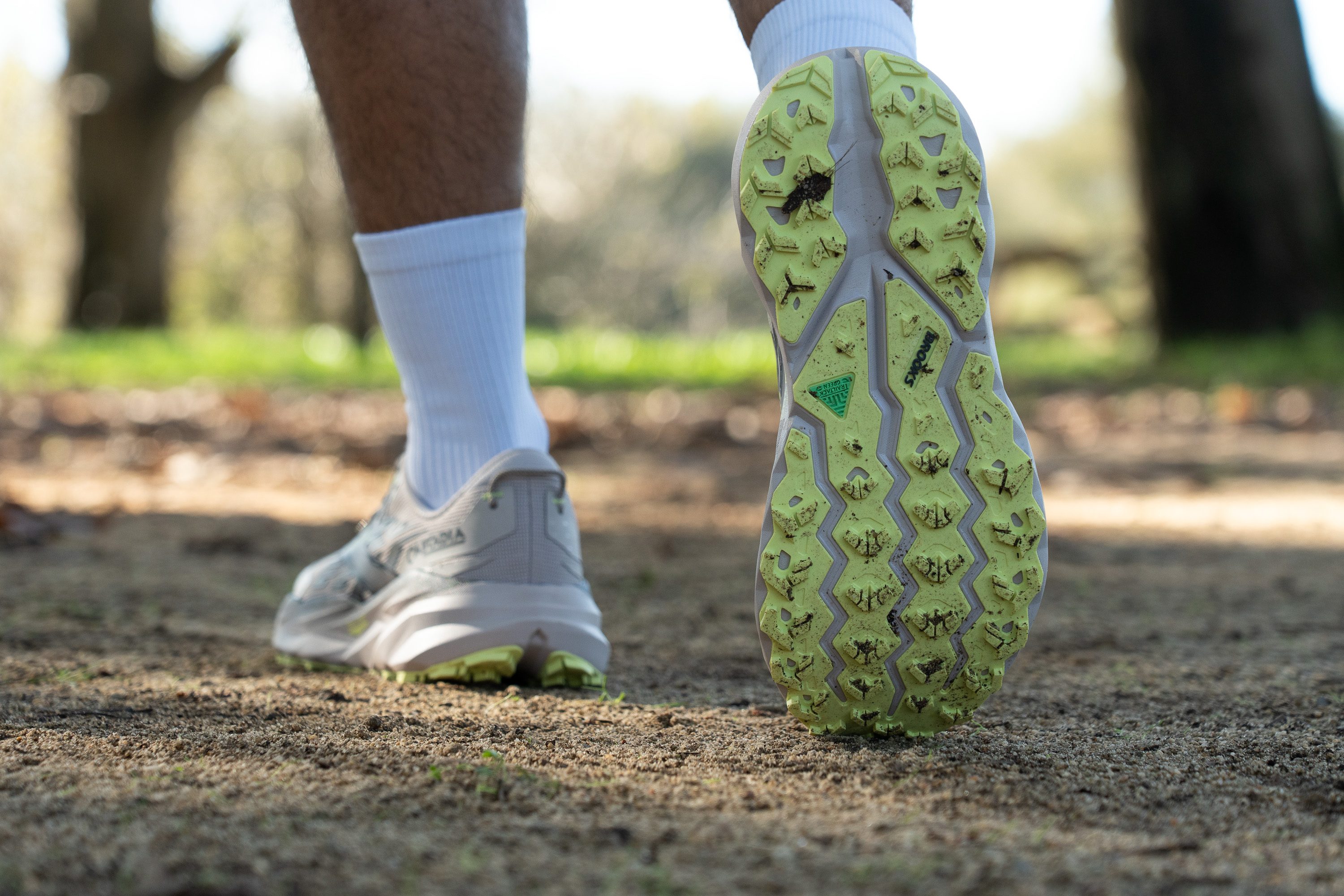
Flexibility / Stiffness
The redesigned outsole and the supercritical DNA Loft v3 foam bring an unexpected yet welcome benefit for anyone seeking long-hike comfort or smooth trail running: flexibility has noticeably improved, giving the shoe a more natural feel.
Version 19 went down to 15.6N (from 17.3N in version 18) despite its higher stack and the same Trail Adapt plate.
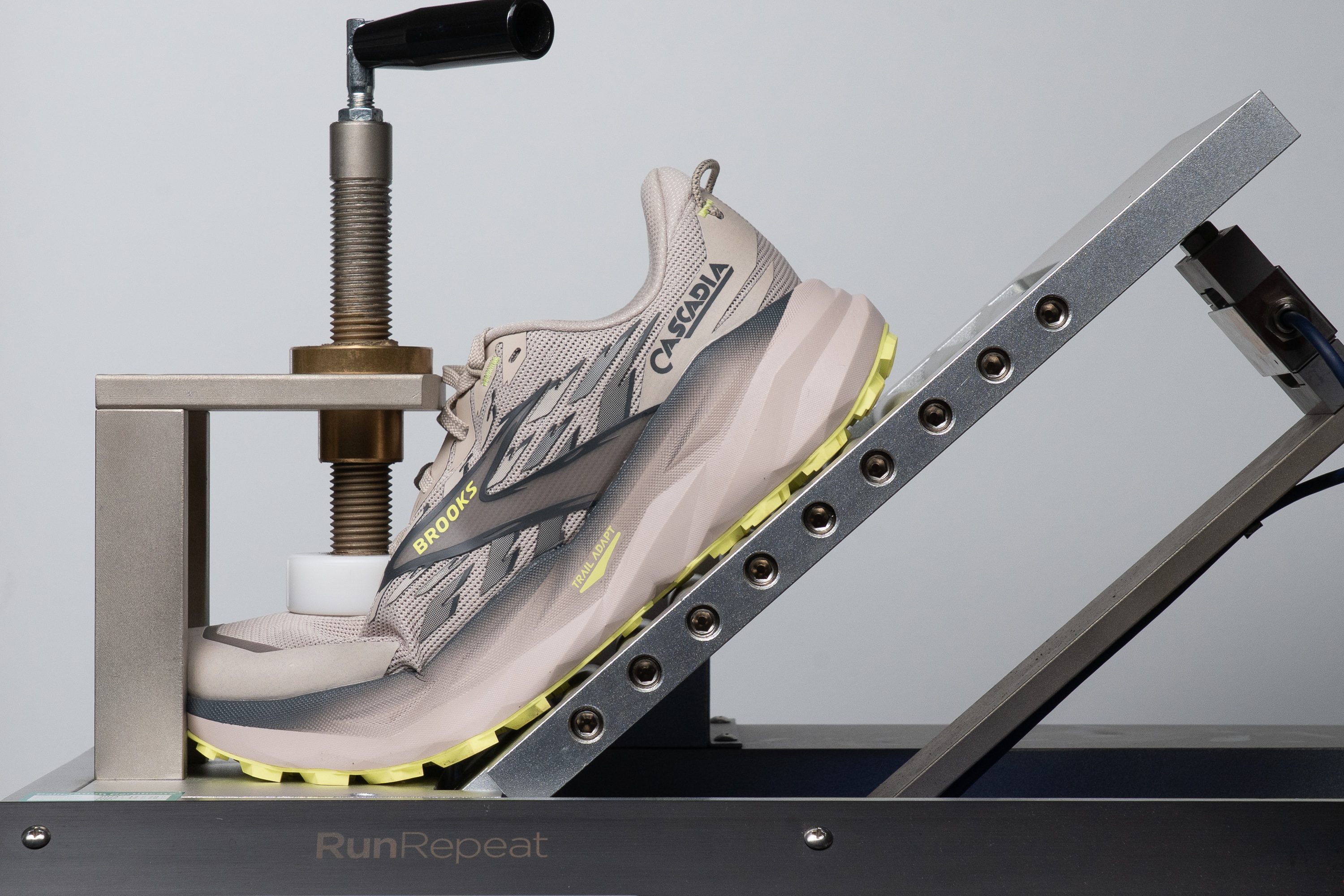
| Cascadia 19 | 15.6N |
| Average | 14.6N |
Weight
The Brooks Cascadia 19 shows a very slight weight drop from its predecessor, now coming in at 10.8 oz (306g) instead of 10.9 oz (310g).
Why isn’t it much lighter if the new foam is? Well, that’s because it also packs significantly more cushioning in both the heel and forefoot, balancing things out. Still, the Cascadia 19 remains a touch heavier than we’d like, and it's also heavier than its dimensions suggest. There's still work to do here, Brooks.
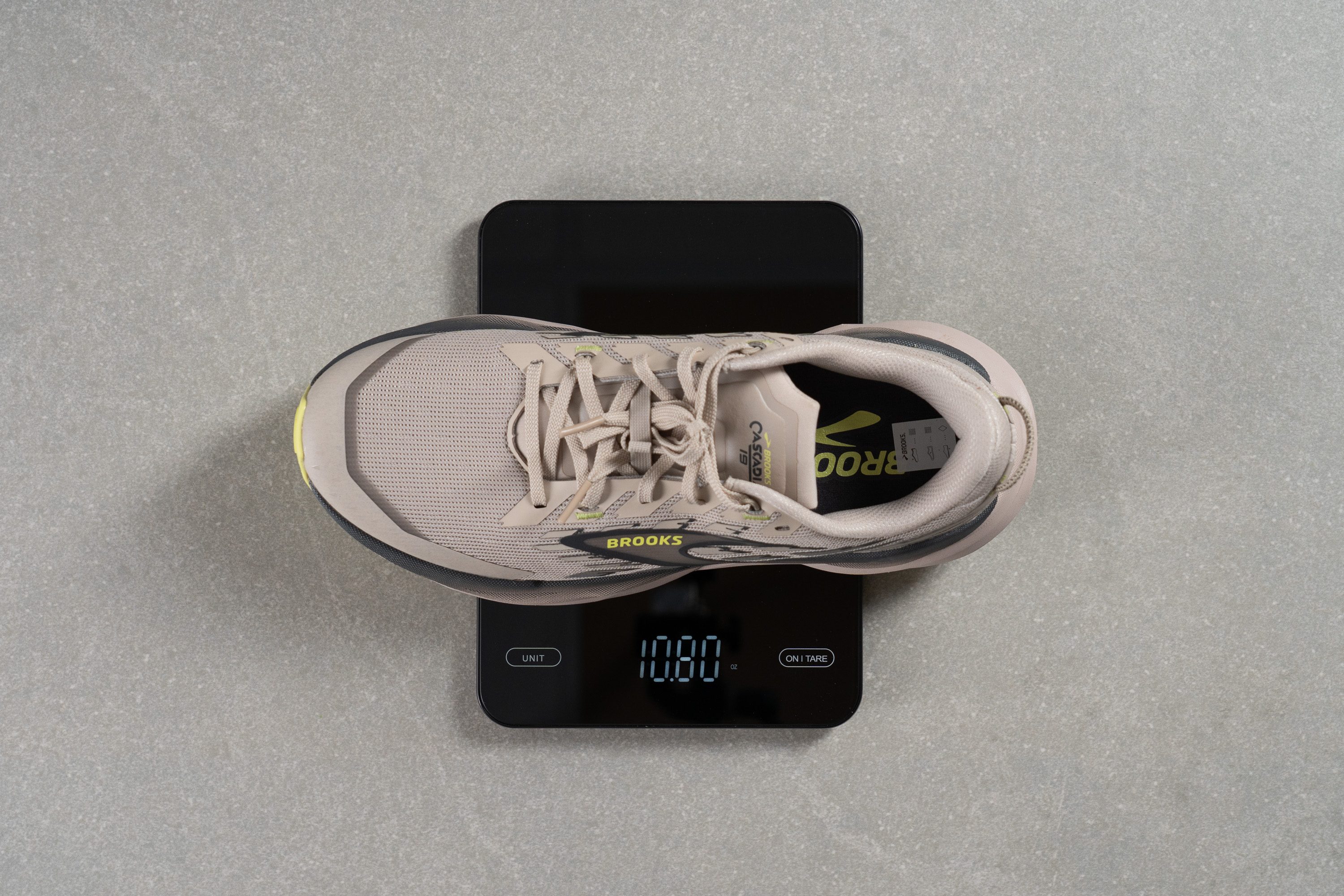
| Cascadia 19 | 10.8 oz (306g) |
| Average | 10.2 oz (289g) |
Breathability
Trail shoes benefit from having enough airflow to stay comfortable but not so much that warmth and protection are lost. That’s why we were happy to see the Cascadia 19 land at a 4/5 rating in our breathability test.
Brooks designed this upper with a lightweight, finely engineered mesh combined with more durable, comfort-focused materials in strategic zones.
Under the microscope, we examined the mesh and found it nicely perforated for breathability, which perfectly explains the strong result we achieved in our test.
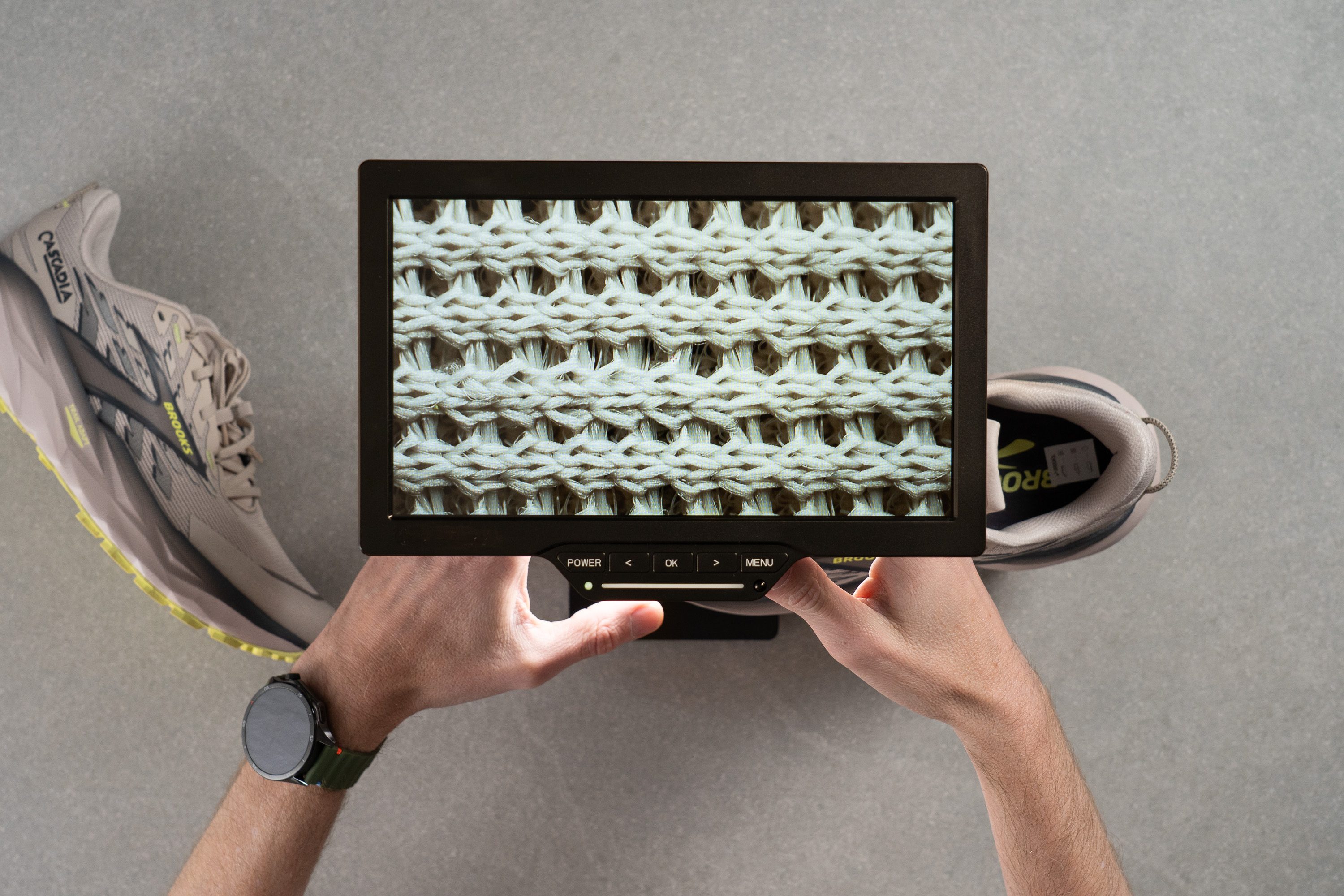
Overall, the upper makes a solid impression—not just for its performance but also for its build quality, especially considering the shoe’s price point.
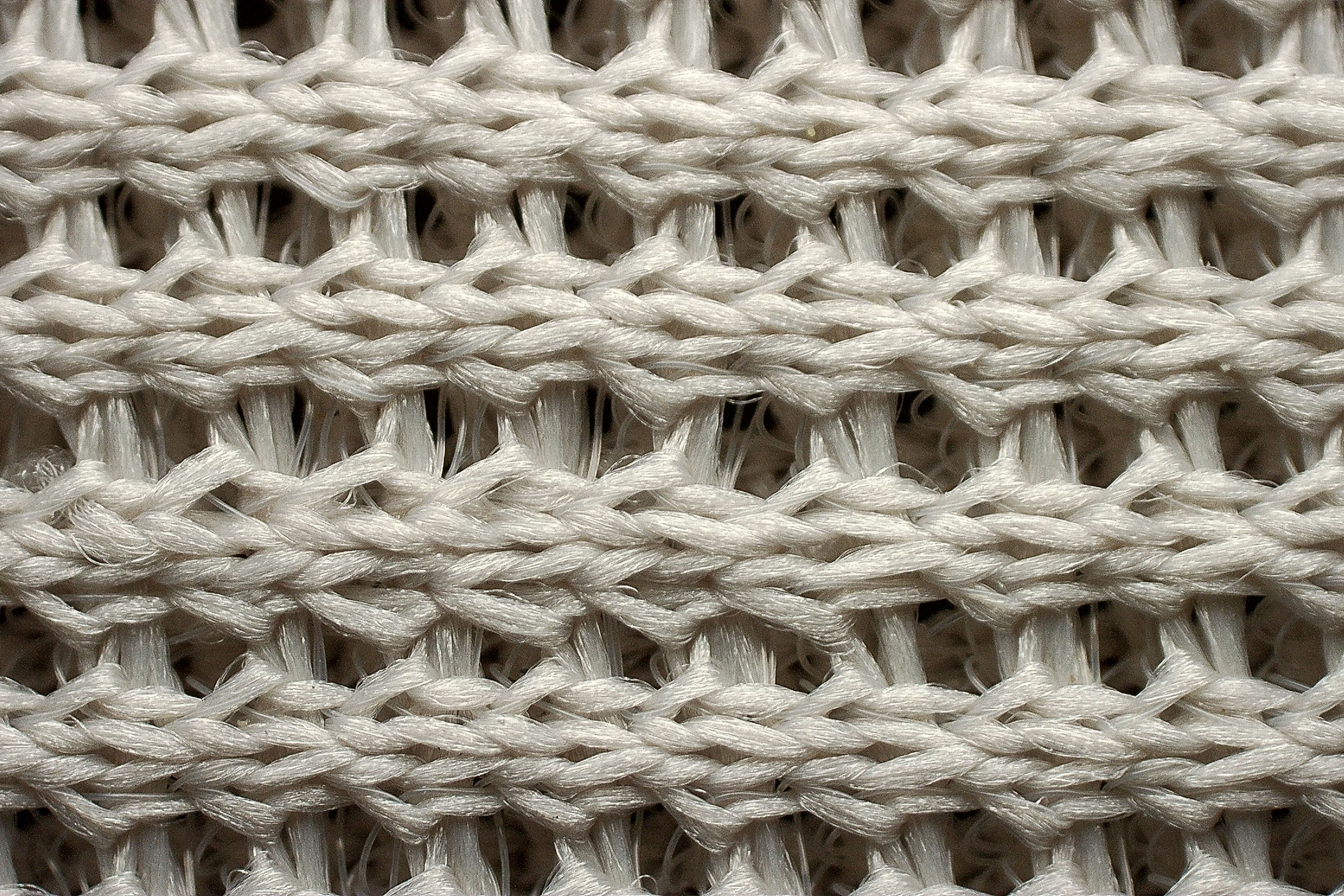
The heel and midfoot are generously padded, delivering a plush feel, though airflow in these areas is naturally reduced to improve durability and maintain a secure fit.
| Cascadia 19 | 4 |
| Average | 3.2 |
Stability
Lateral stability test
The Cascadia 19 introduces a softer foam, which might make many assume stability has taken a hit.
However, that’s far from true. Brooks made a major adjustment to the midsole dimensions to preserve the series’ signature stable ride, though it does result in a bulkier shoe that may not appeal to everyone.
Torsional rigidity
Torsional rigidity stays at a solid 4/5, which we genuinely appreciate. Even with the Trail Adapt plate, Brooks managed to maintain a flexible feel thanks to the clever outsole design and the softer DNA Loft v3 foam.
| Cascadia 19 | 4 |
| Average | 3.6 |
Heel counter stiffness
Brooks also made a subtle but meaningful adjustment to the heel counter stiffness. In the previous model, we found it overly rigid and somewhat intrusive, but it’s now reduced to 4/5, striking a far better balance between comfort and stability.
| Cascadia 19 | 4 |
| Average | 3 |
Midsole width - forefoot
Here’s where the Cascadia 19 truly sets itself apart from its predecessor: its platform is now impressively wide.
The previous version measured 112.6 mm, close to average, but version 19 jumps to a massive 121.5 mm, giving it outstanding stability despite the softer, more forgiving foam.
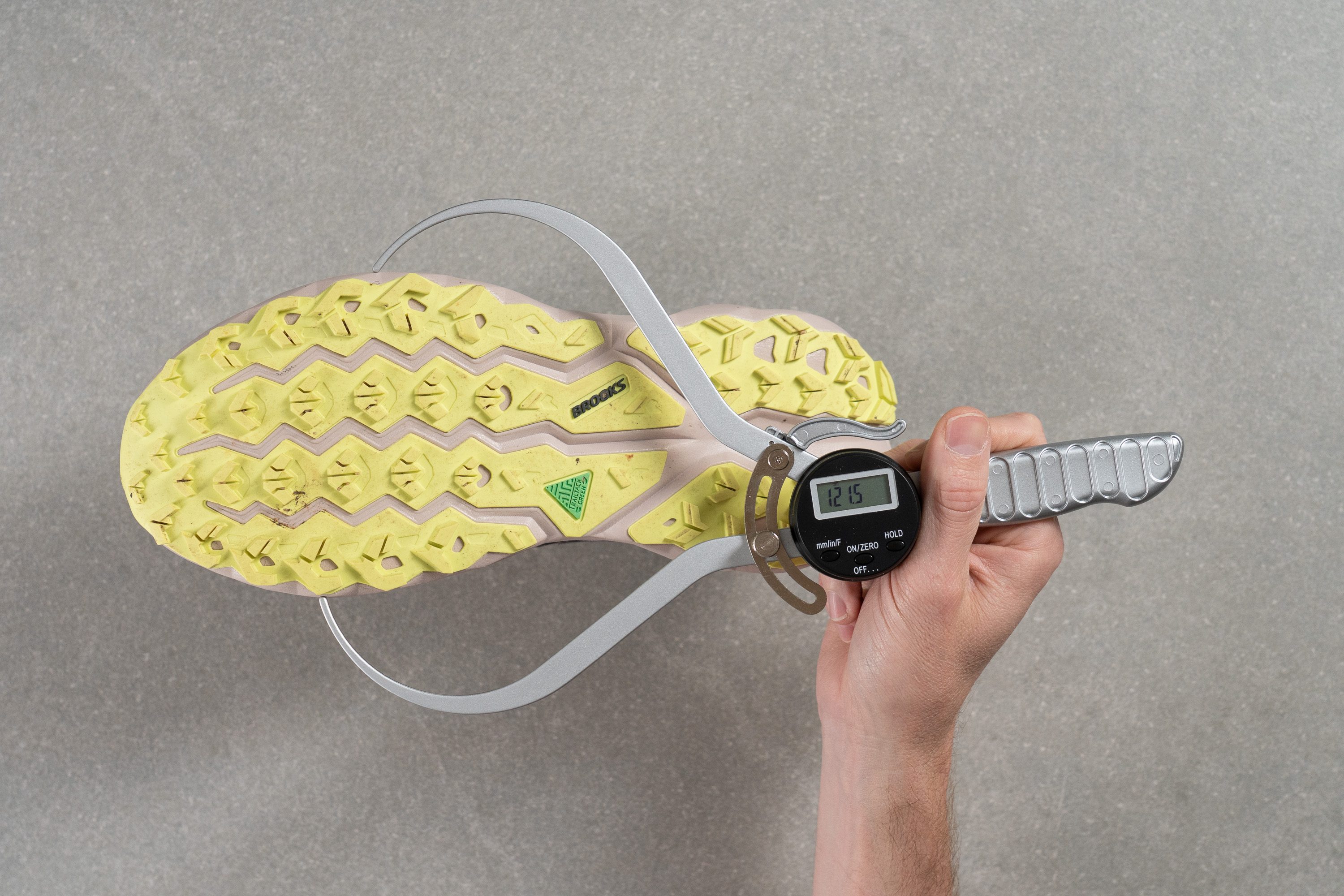
| Cascadia 19 | 121.5 mm |
| Average | 112.8 mm |
Midsole width - heel
The heel has also expanded to 101.3 mm, giving the Cascadia 19 proportions similar to many road stability shoes. This wider base greatly enhances stability, though it can make the shoe feel a bit bulky for hiking, where that extra width isn’t really necessary.
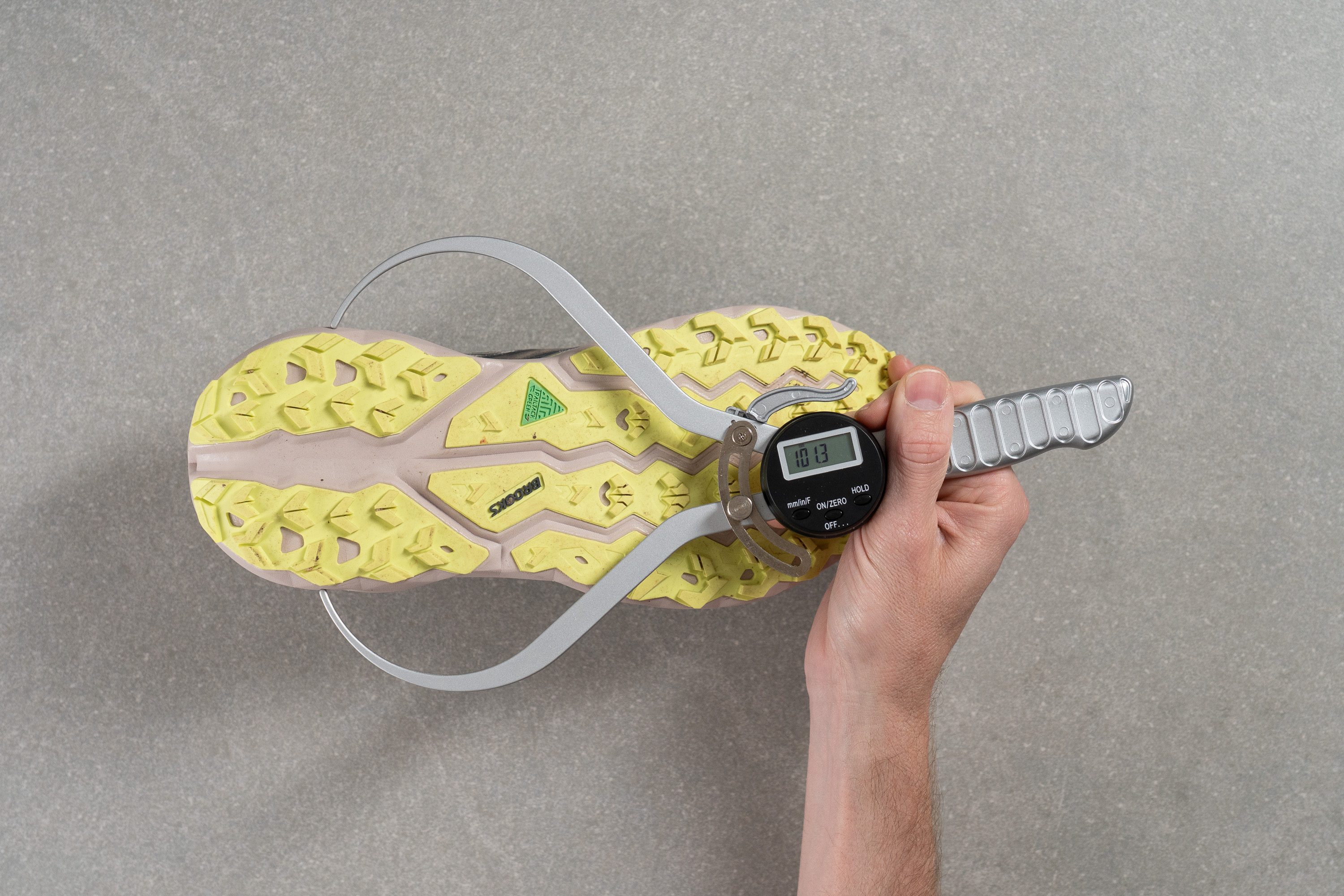
| Cascadia 19 | 101.3 mm |
| Average | 89.8 mm |
Durability
Toebox durability
We found a very solid outcome in our toebox durability test, with the Cascadia 19 earning a 4/5 score. The extra-durable toe bumper played a major role here, since we tested in the same standardized spot as in every other shoe.
| Cascadia 19 | 4 |
| Average | 3.1 |
Heel padding durability
Heel padding was less impressive, earning a 3/5 in our test, though it still passed our standards. We believe there’s room for improvement to make it more resilient and long-lasting.
| Cascadia 19 | 3 |
| Average | 3 |
Outsole durability
The TrailTack Green rubber truly impressed us. Using our tire tread gauge, we discovered that only 0.7 mm of material wore away, a remarkably low number that highlights its excellent durability.
| Cascadia 19 | 0.7 mm |
| Average | 0.9 mm |
Outsole thickness
The outsole measures 1.9 mm in thickness, and we believe Brooks could easily trim it slightly further if needed to shave off a bit of extra weight.
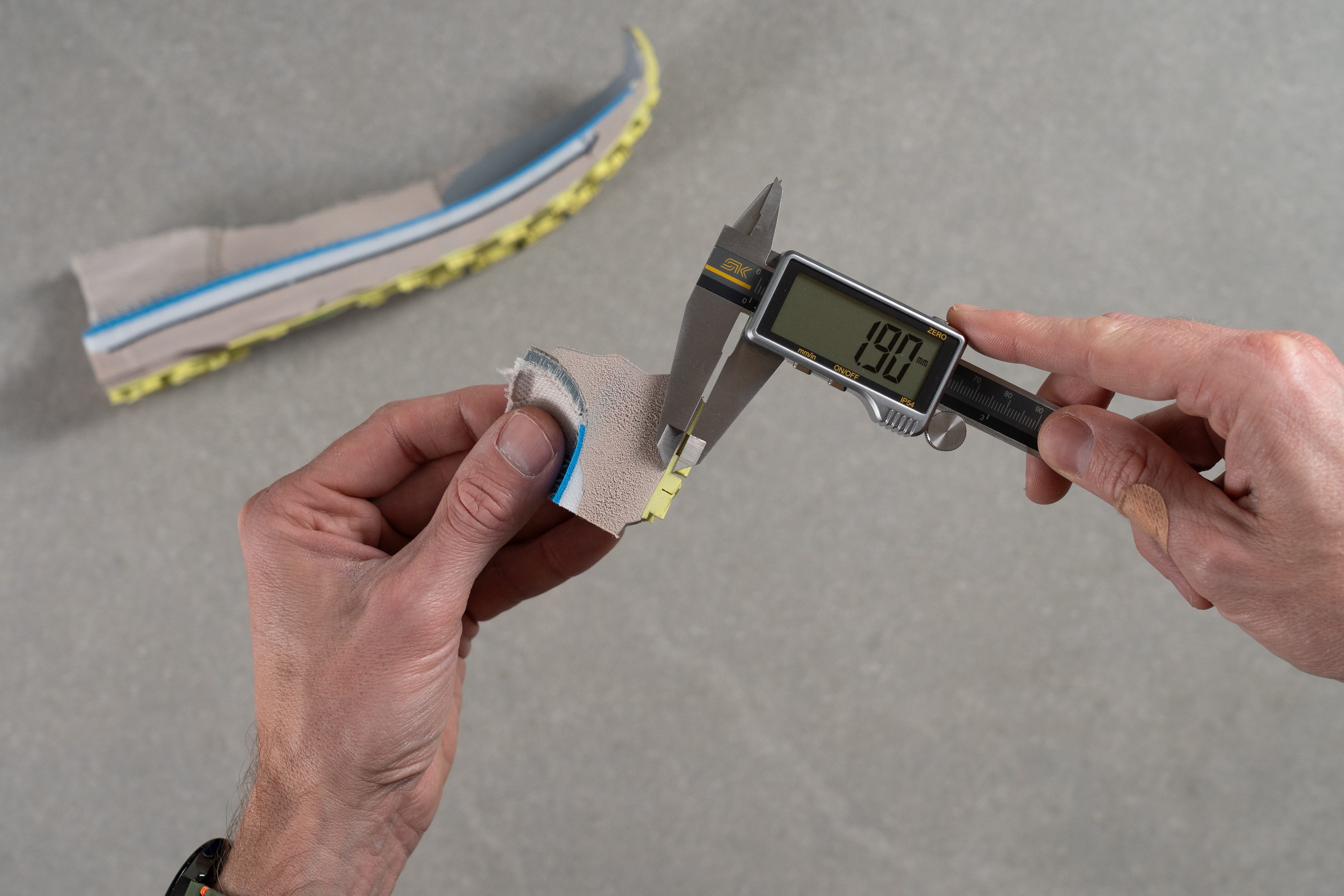
| Cascadia 19 | 1.9 mm |
| Average | 2.2 mm |
Misc
Insole thickness
From the entire cushioning setup, we measured that 5.0 mm come from the insole itself.
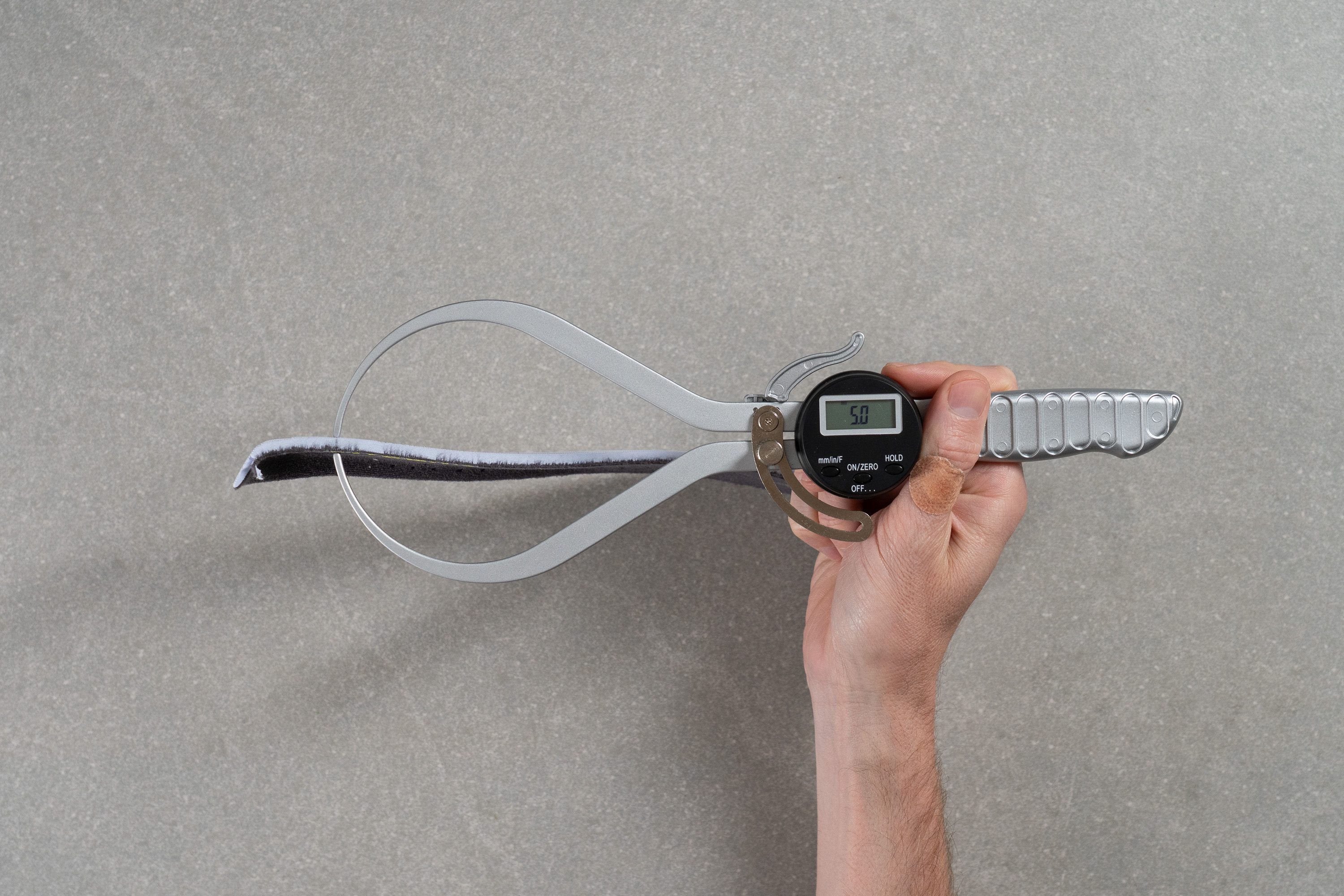
| Cascadia 19 | 5.0 mm |
| Average | 4.7 mm |
Removable insole
The insole is removable, as we confirmed during testing. However, it’s nicely perforated to boost ventilation, a superb touch that makes it worth keeping rather than swapping for another option.
| Cascadia 19 | Yes |
Midsole softness in cold (%)
The shift from basic EVA to supercritical EVA is a welcome improvement, but at the end of the day, it’s still EVA. So we weren’t expecting standout results in our 20-minute freezer test, and indeed, the Cascadia 19 showed a 30% drop in softness.

| Cascadia 19 | 30% |
| Average | 26% |
Reflective elements
Unfortunately, we didn’t find any reflective elements on the Cascadia 19. While it’s not a major flaw, we always appreciate to have them for low-light runs, and considering how easy and inexpensive they are...
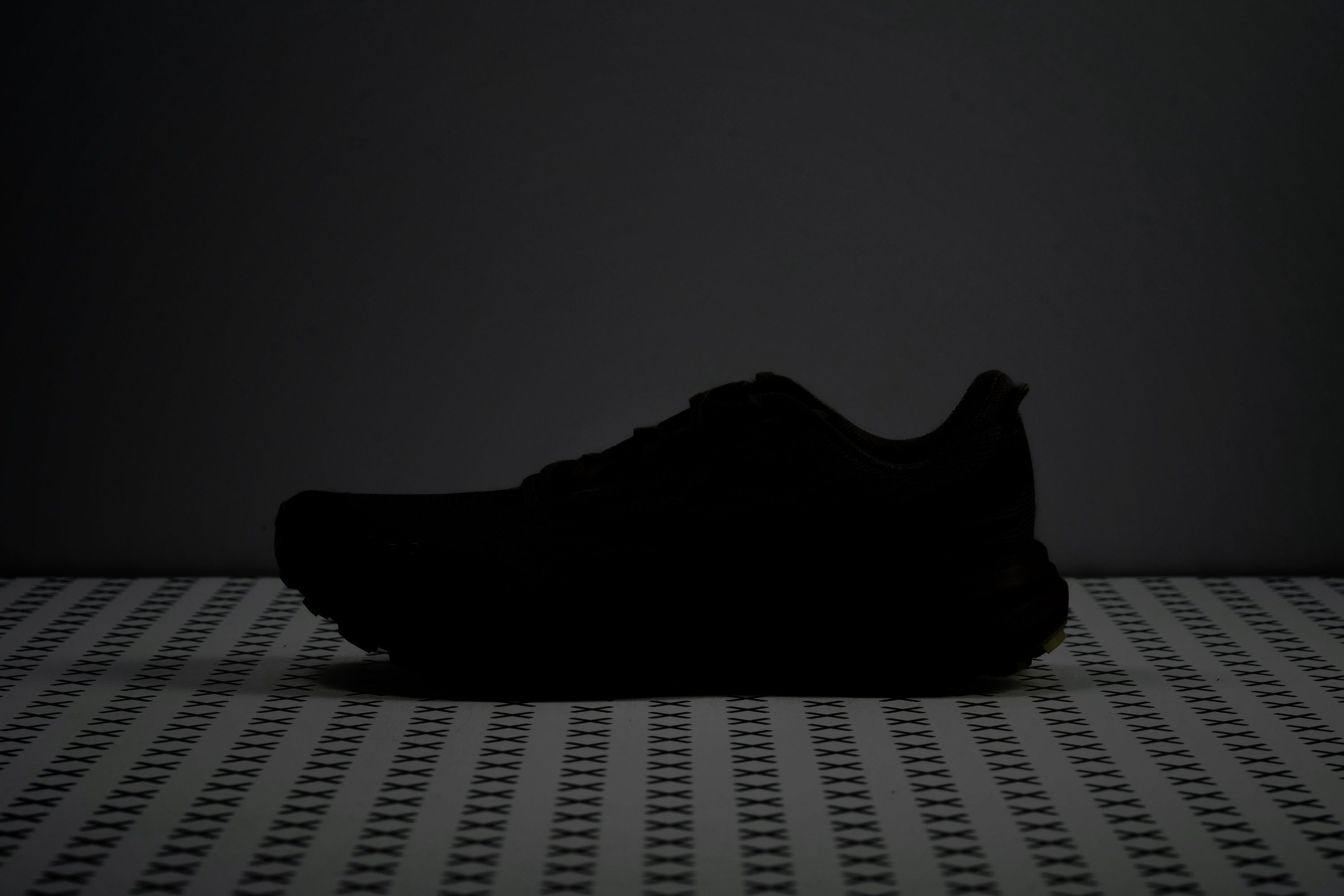
| Cascadia 19 | No |
Tongue padding
The Cascadia’s lacing system uses a hybrid setup combining punched eyelets with two loops on each side. The slightly textured laces feel good, and we loved the elastic band that neatly keeps them in place.
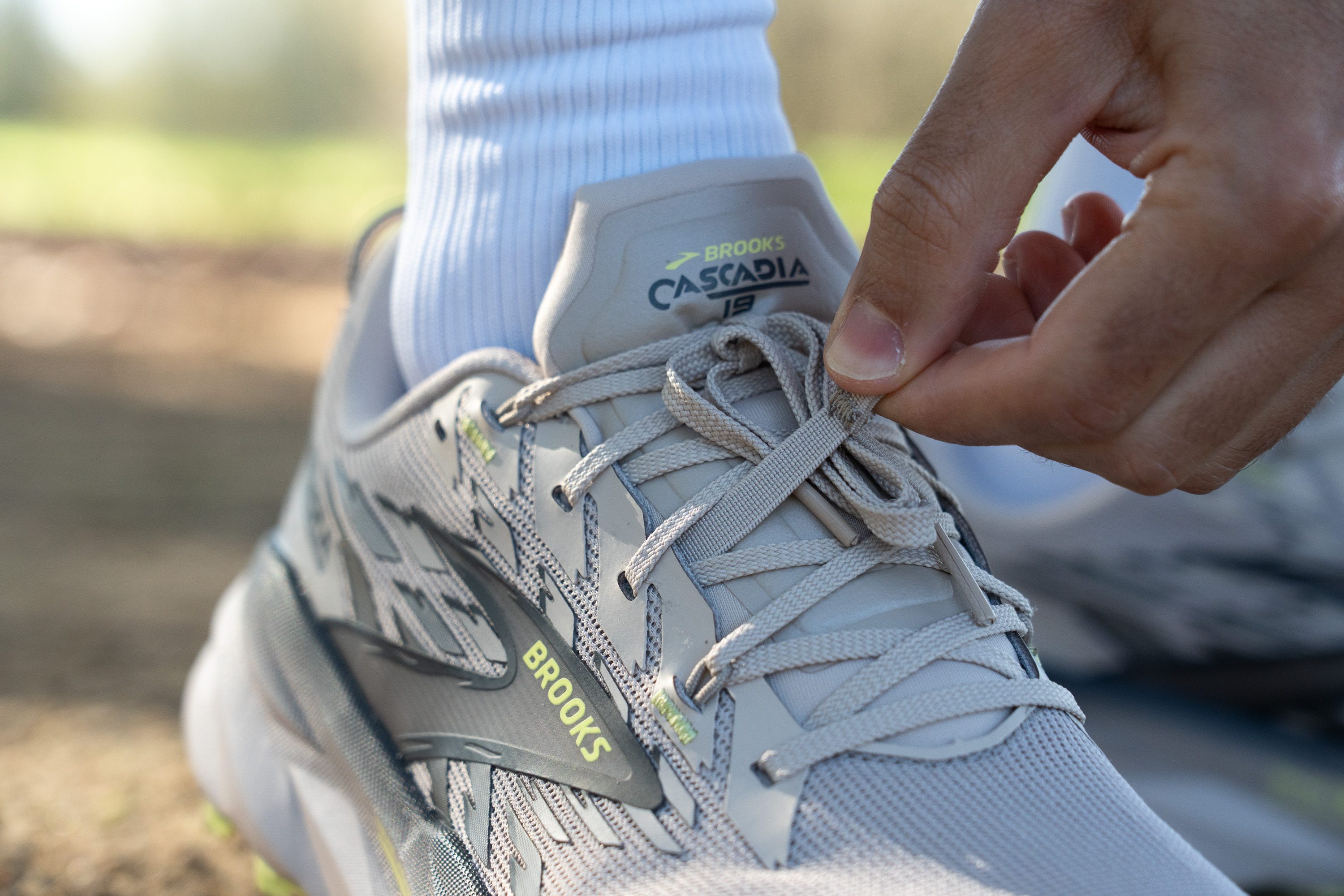
When it comes to comfort, Brooks didn’t hold back. The tongue is generously padded, measuring 10.1 mm with our digital calipers. Sure, it adds a bit of weight, but we think the trade-off is worth it.
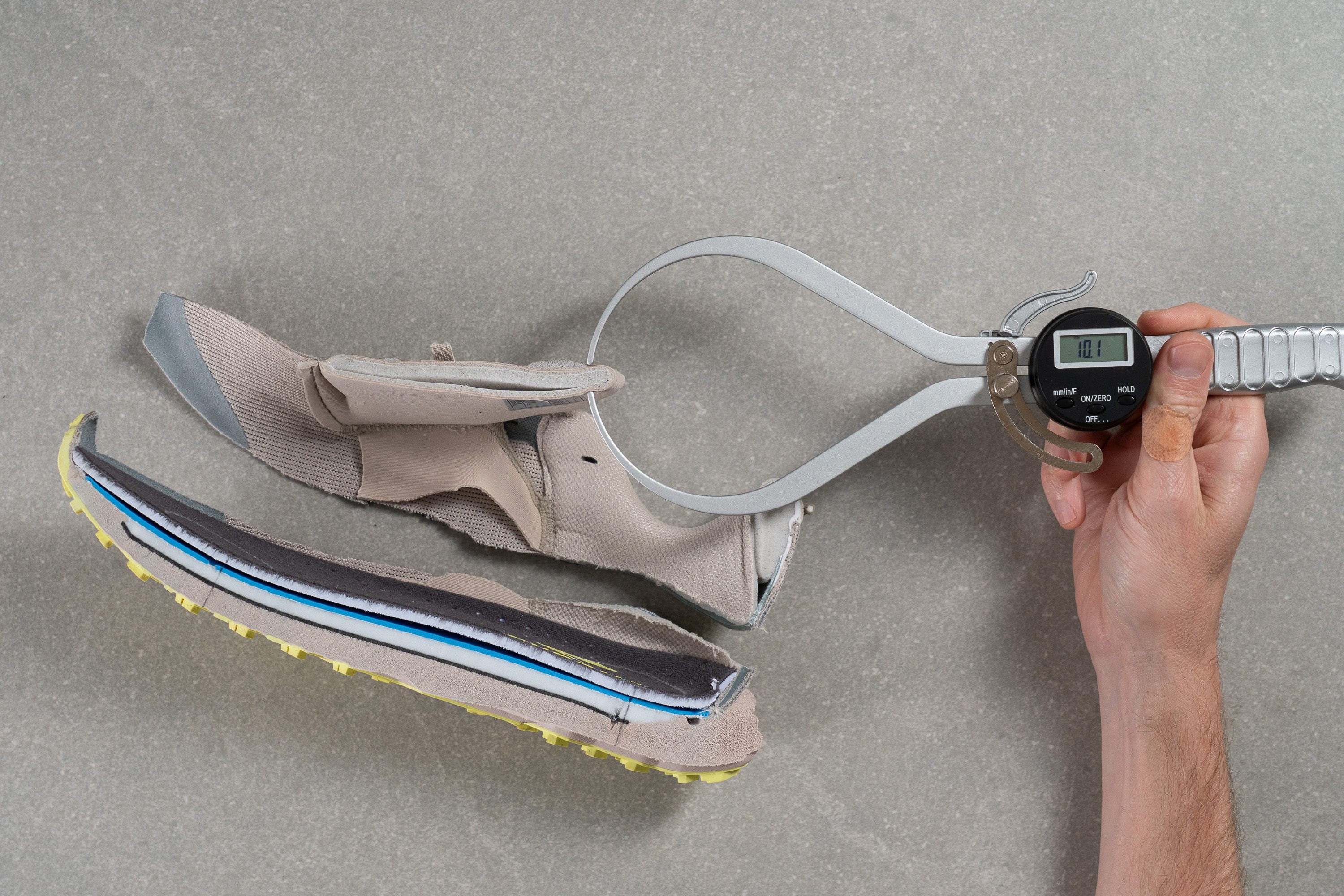
| Cascadia 19 | 10.1 mm |
| Average | 6.4 mm |
Tongue: gusset type
We appreciated that the tongue is fully attached to the sides, which enhances lockdown and keeps out debris for a cleaner, more secure running experience.
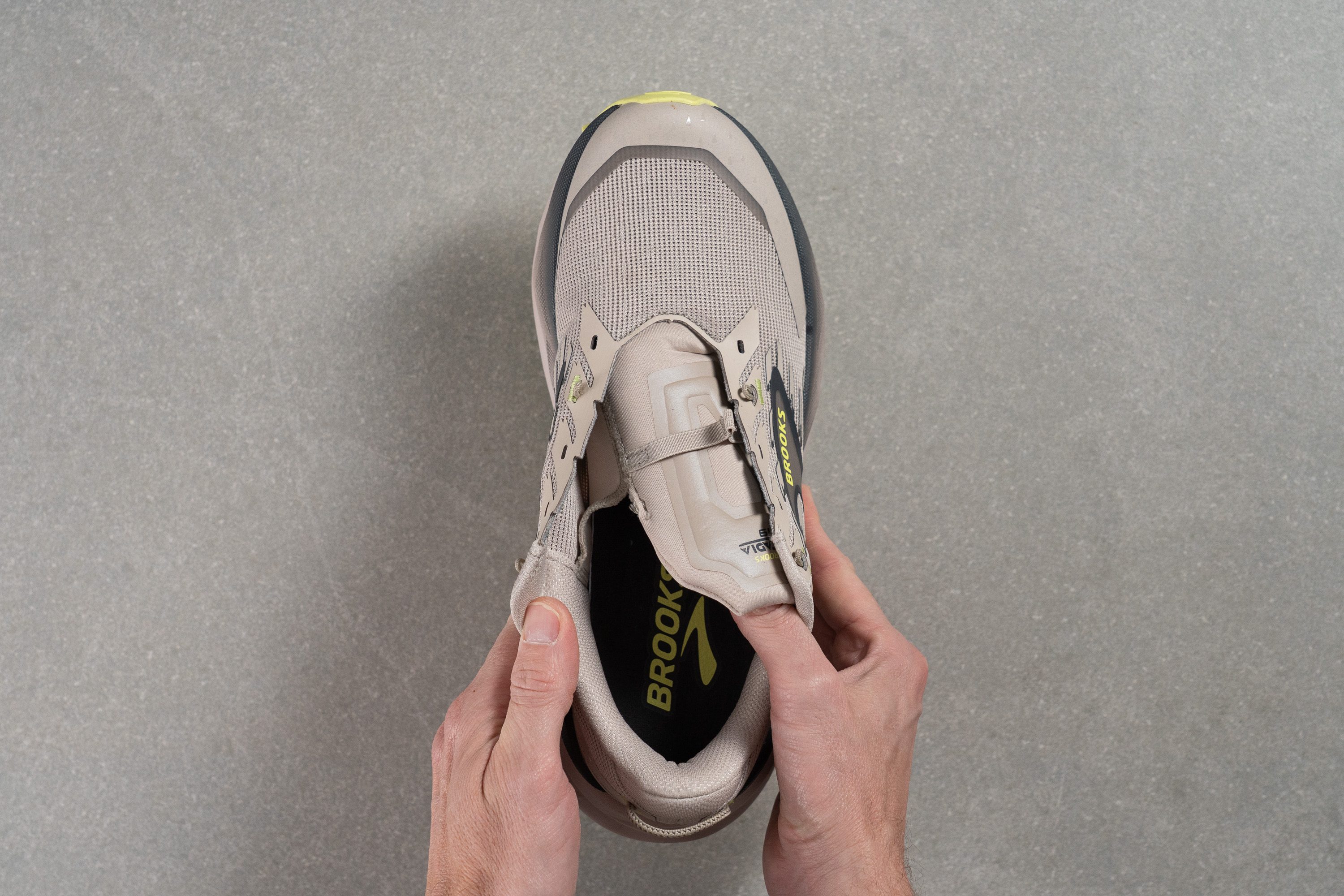
| Cascadia 19 | Both sides (full) |
Price
The Cascadia 19 sees a slight price increase over its predecessor, but we think it’s absolutely justified if that’s the cost of the foam upgrade. Brands often raise prices after major updates, and we hope this one to stay steady for the next 2-3 years.
| Cascadia 19 | $150 |
| Average | $152 |
Heel tab
The heel features a thin, horizontal finger-loop tab that left us a bit uncertain, as it looks less sturdy than a traditional wider loop. Still, despite our strong tugs during testing, it held up perfectly, so time will tell...
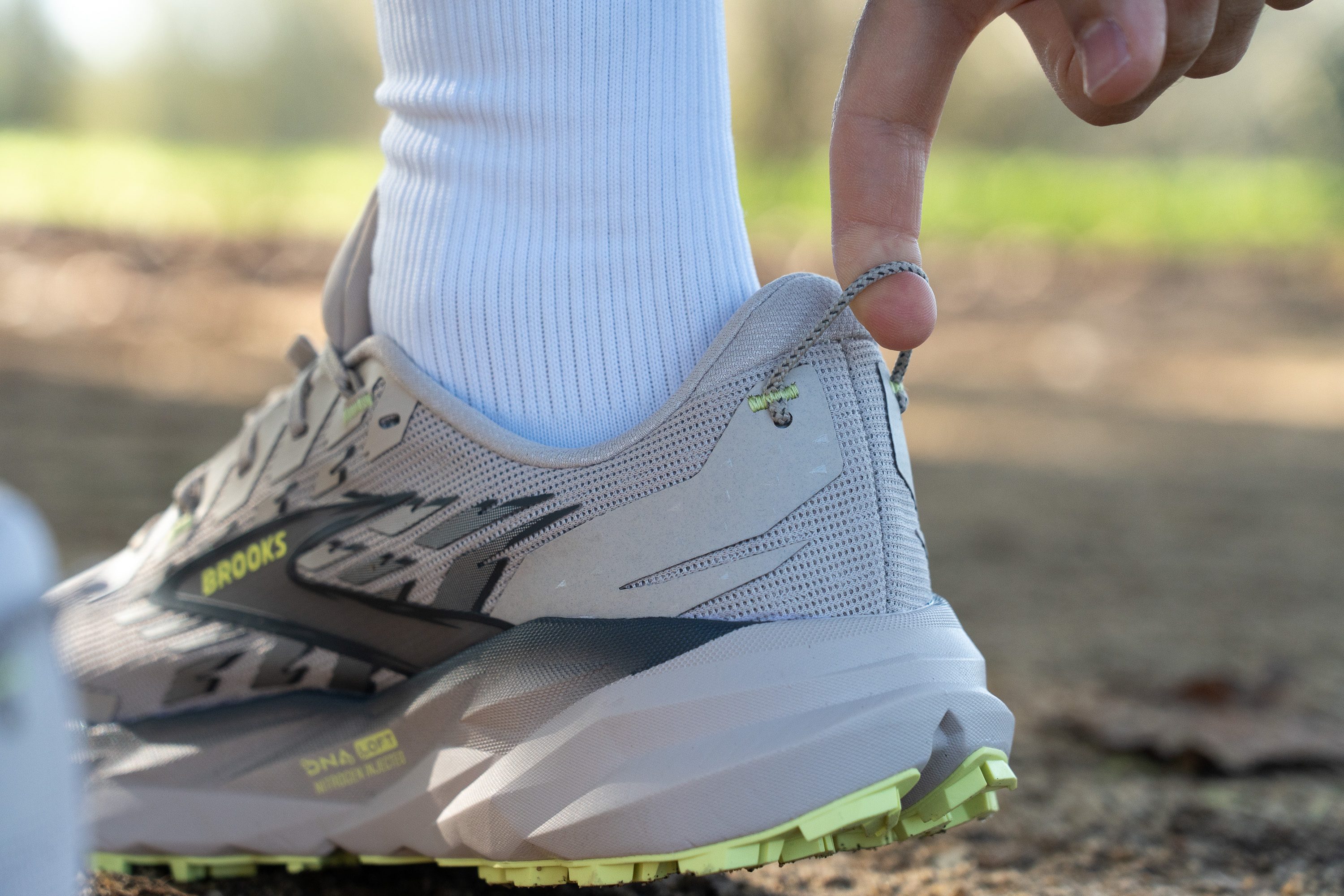
| Cascadia 19 | Finger loop |

